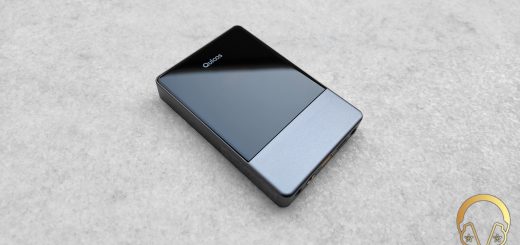iBasso DC-Elite Review

iBasso DC-Elite Review
Introduction:
iBasso has released a its flagship USB DAC/Amplifier dongle: the iBasso DC-Elite. This device boasts a sleek and durable housing made of high-quality titanium alloy material. Inside this compact and portable device, you will find some interesting hardware components such as the ROHM BD34301EKV DAC chip, which provides a high dynamic range, low distortion and a smooth DAC volume control. It also has a 24 position 4 section stepped attenuator, a current output DAC architecture, and 6 dual OPAMPs, which ensure a stable and powerful output for both balanced and single-ended headphones. The in-house developed FPGA and the NDK femtosecond oscillator are some other noteworthy features. The DC-Elite supports up to DSD512x and PCM 32-BIT/768kHz formats.
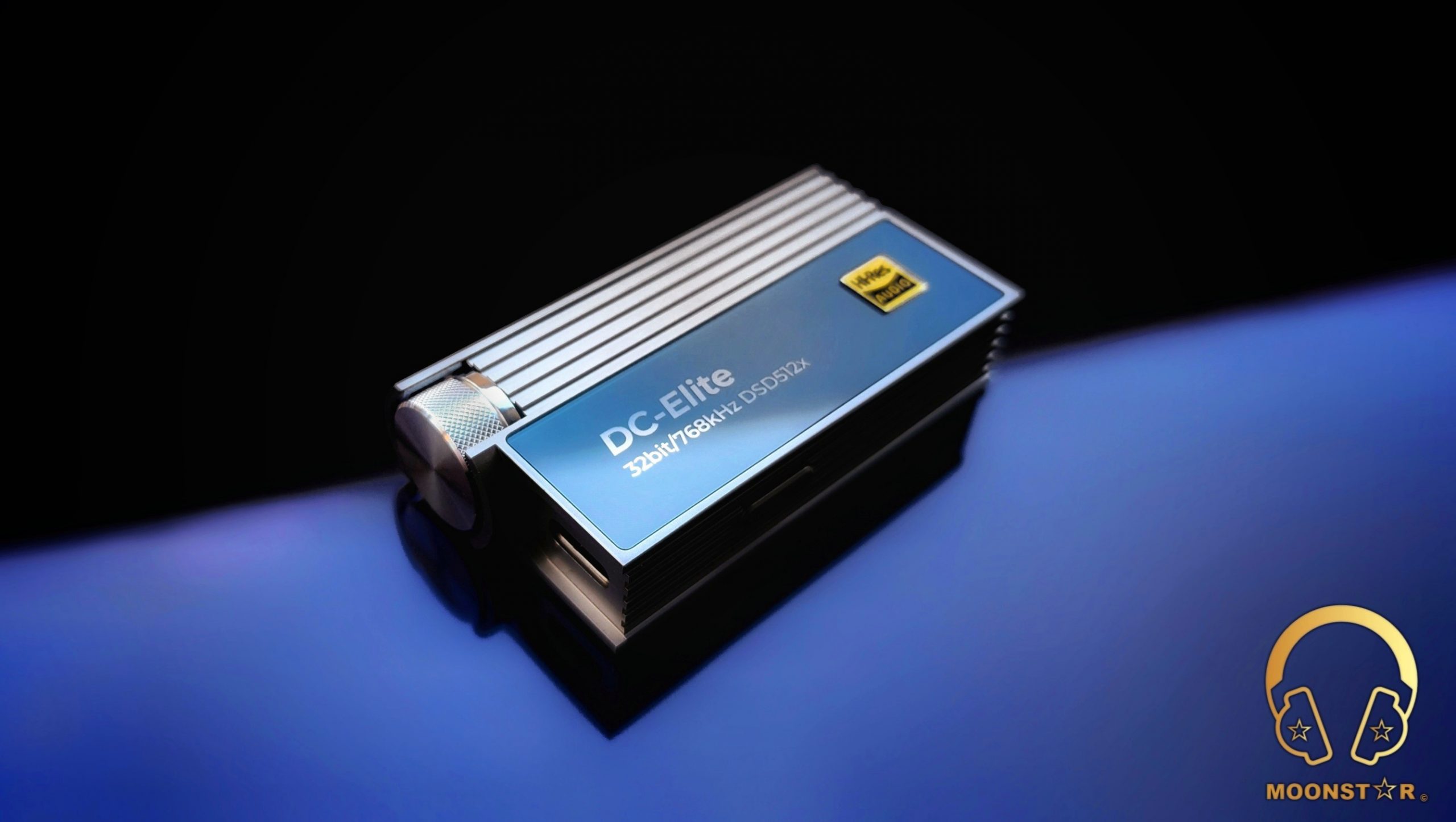
Disclaimer:
I would like to thank iBasso for providing me the DC-Elite USB DAC/Amplifier Dongle as review sample. I am not affiliated with iBasso beyond this review and these words reflect my true and unaltered opinions about the product!
Price & Availability:
The actual price of the iBasso DC-Elite USB DAC/Amplifier dongle is 449.00 US$. More information’s can be found under the link below;
Package & Accessories:
Arriving in a sleek, rectangular package, the iBasso DC-Elite rests inside a protective blue box adorned with the iBasso logo. This box is further enveloped in a glossy white card sleeve showcasing the iBasso branding and a concise product description.
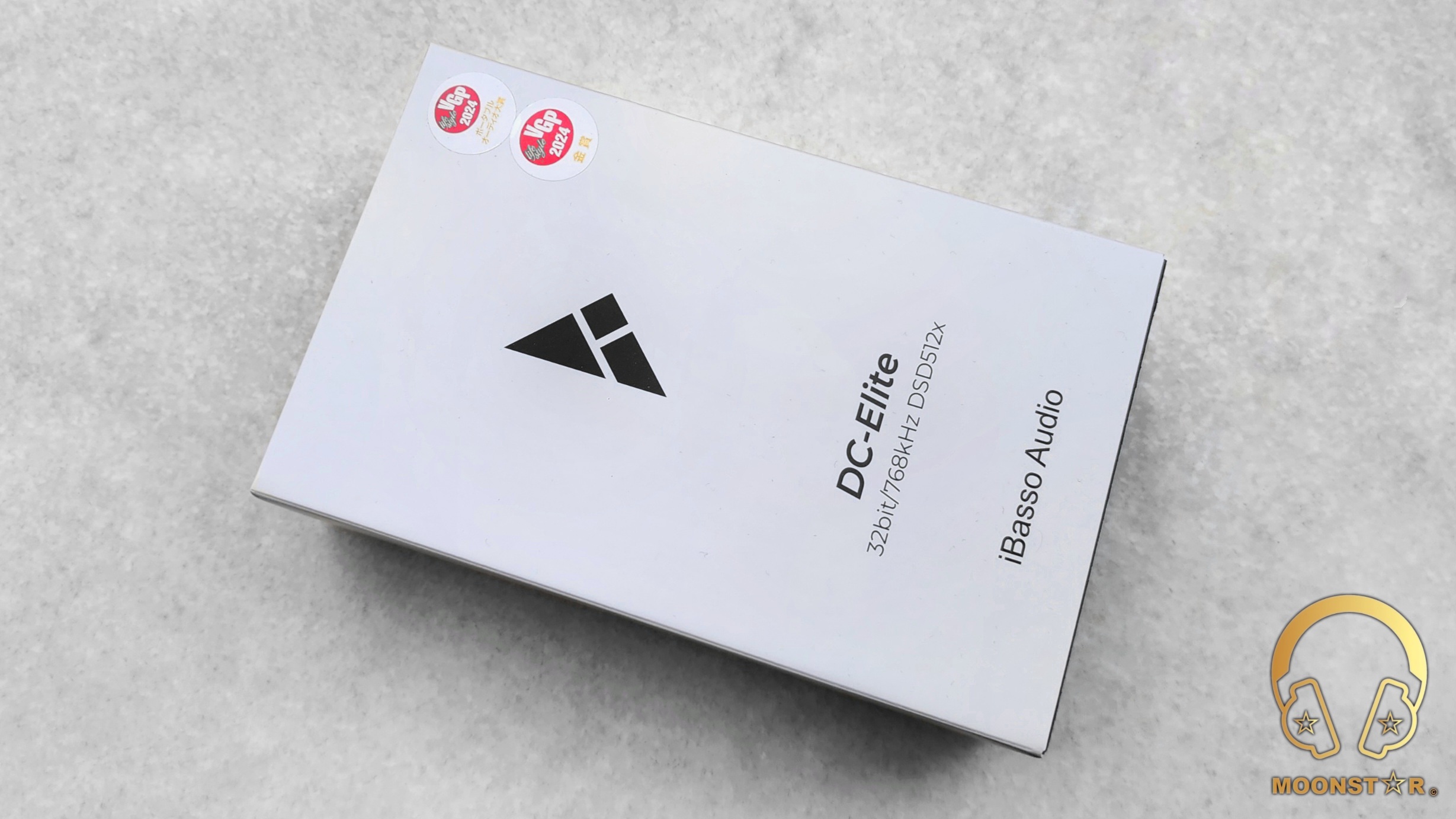
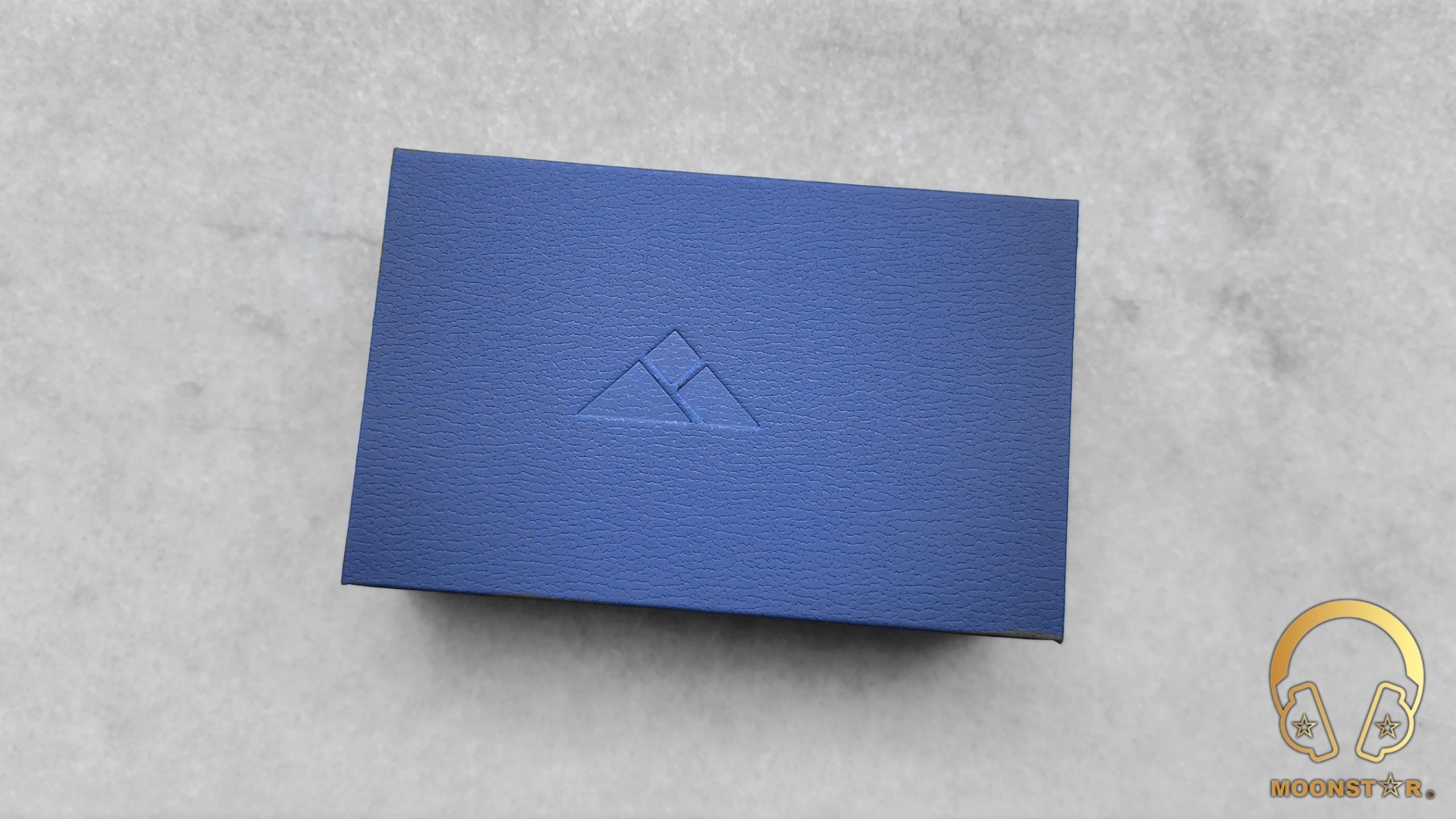
Inside the box are the following contents & accessories;
- 1 x iBasso DC-Elite USB DAC/Amplifier Dongle
- 1 x USB Type-C to USB Type-C cable
- 1 x USB Type C to Lightning Cable
- 1 x USB Type-C to USB A Adaptor
- 1 x Premium Leather Case
- 1 x Cable Storage Bag
- 1 x Print Materials
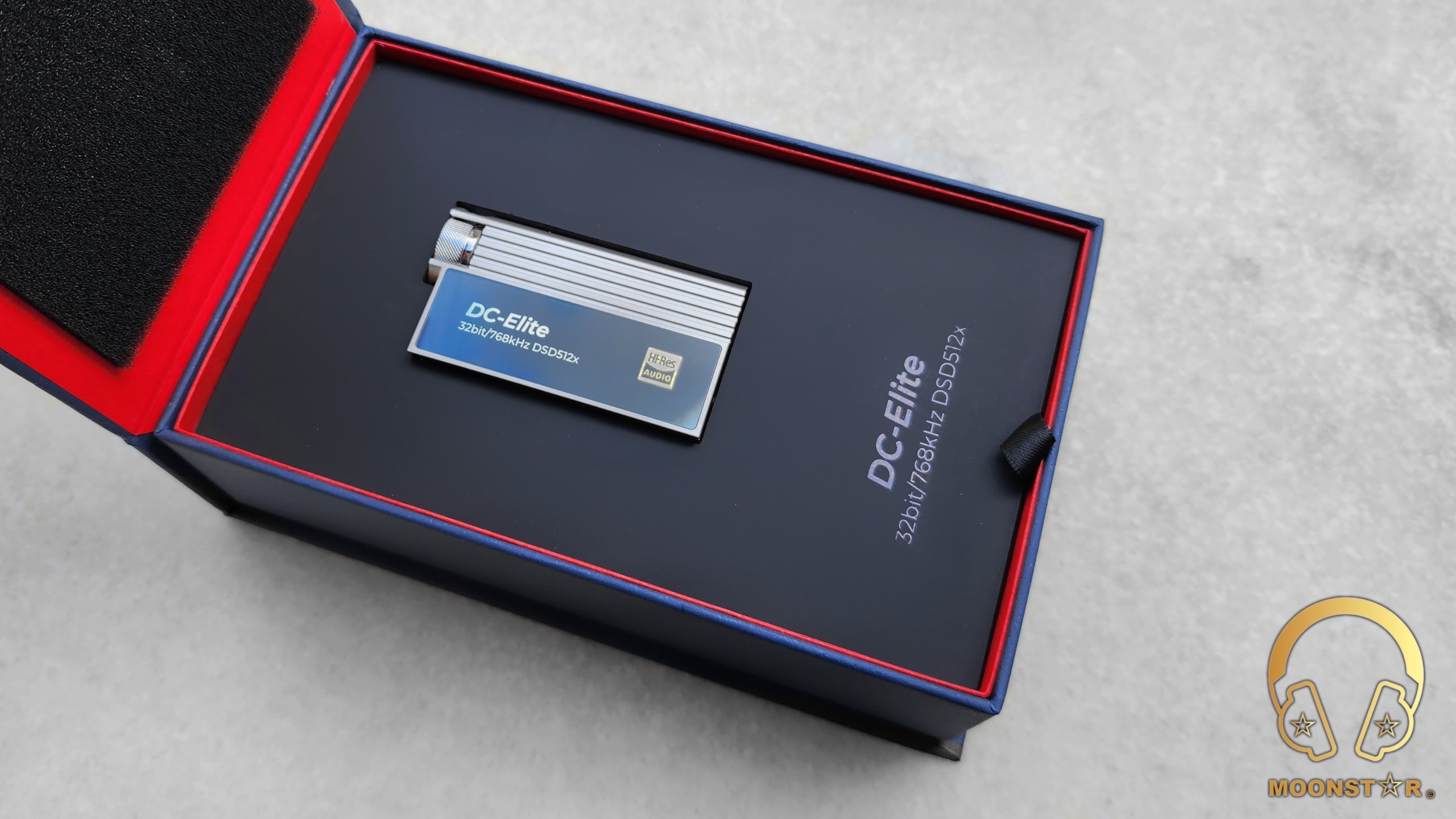
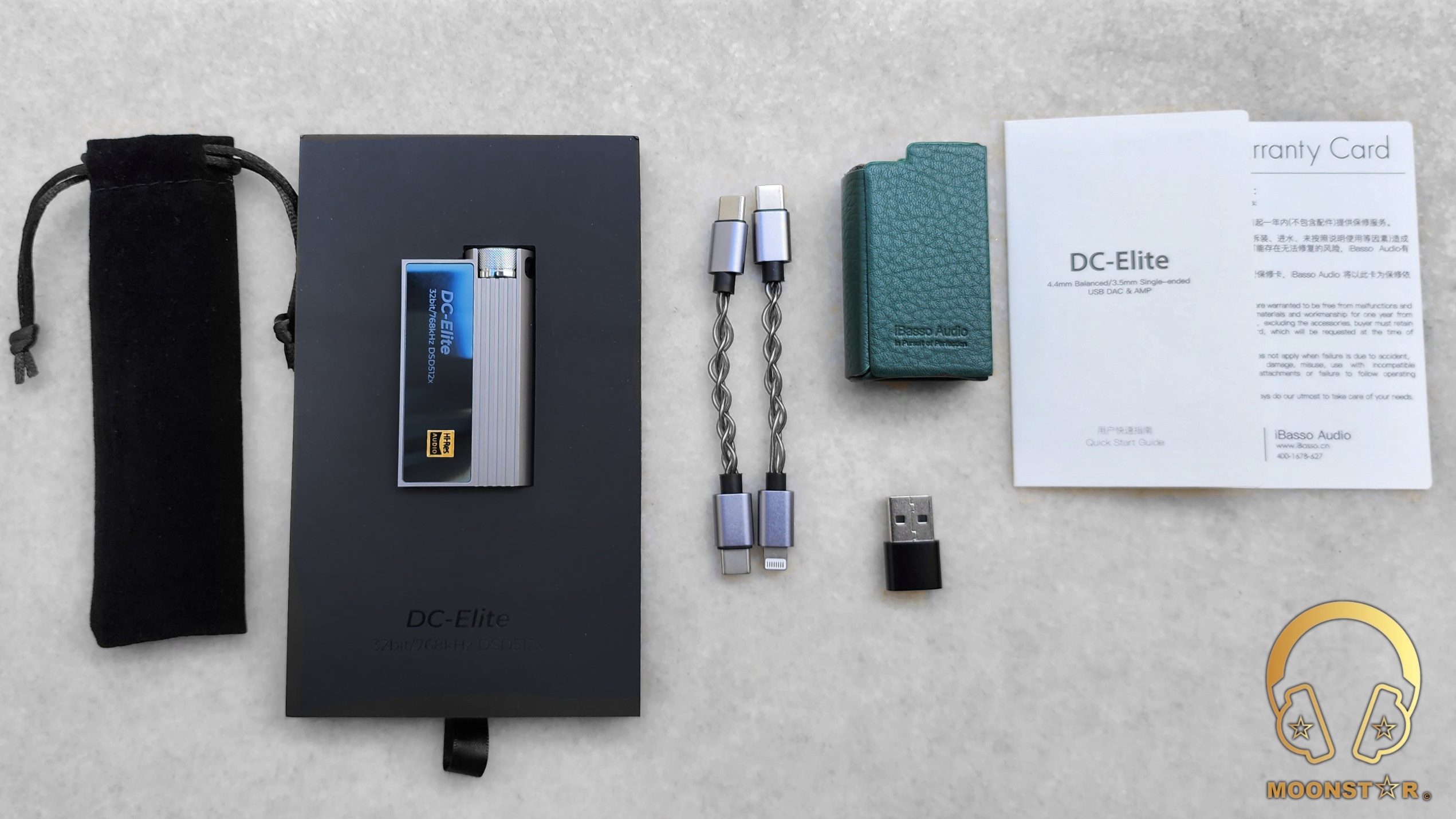
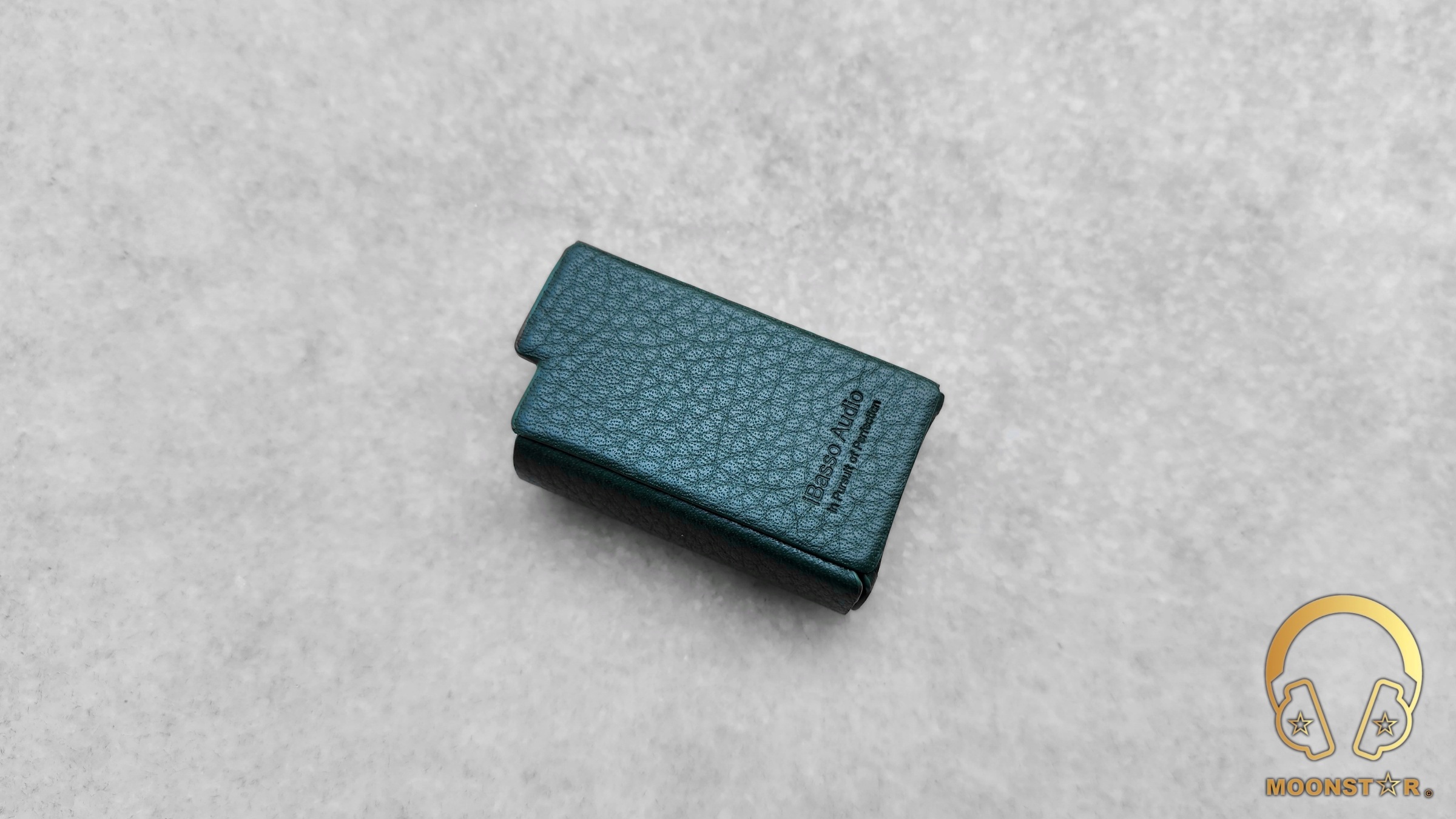
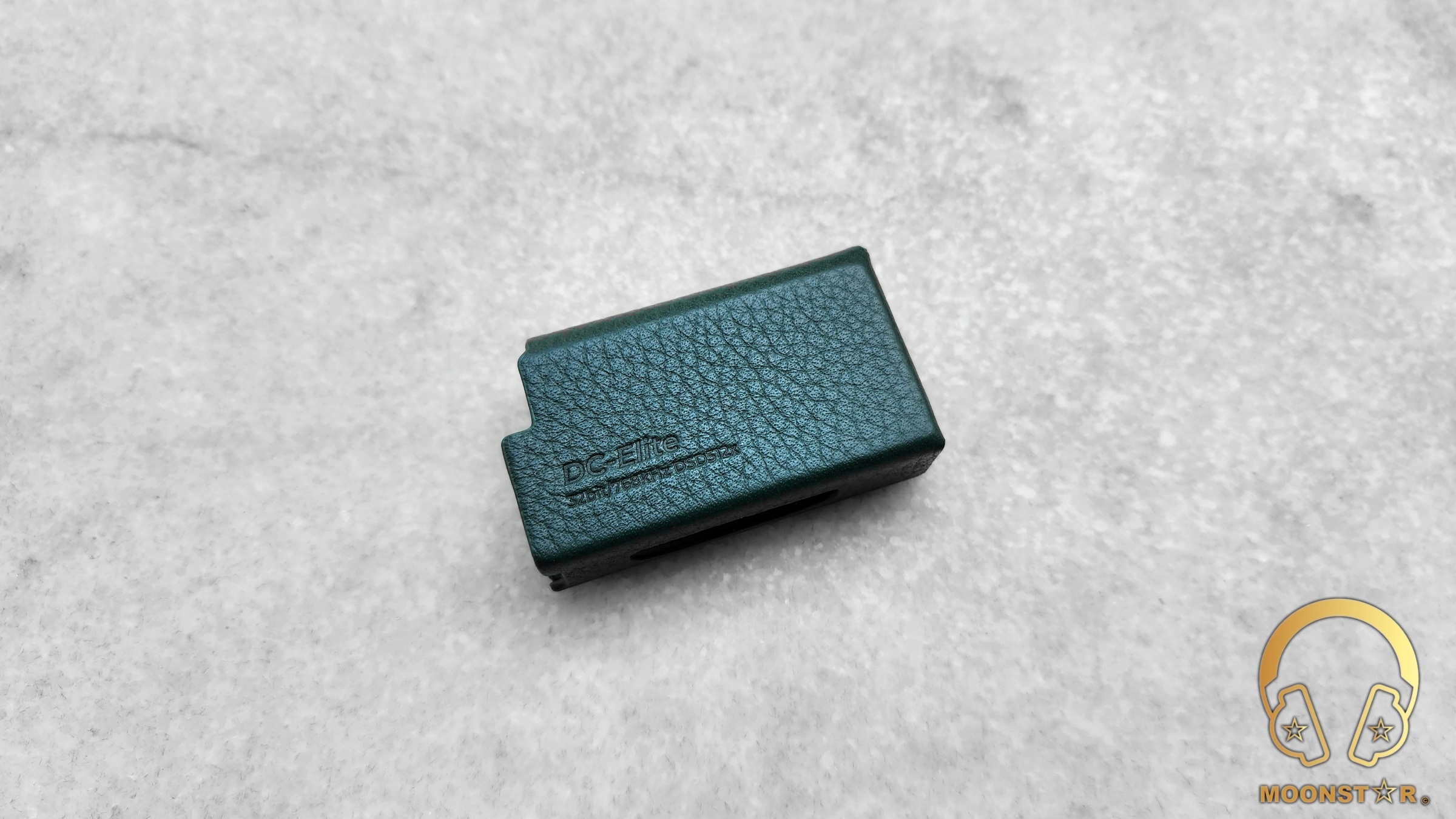
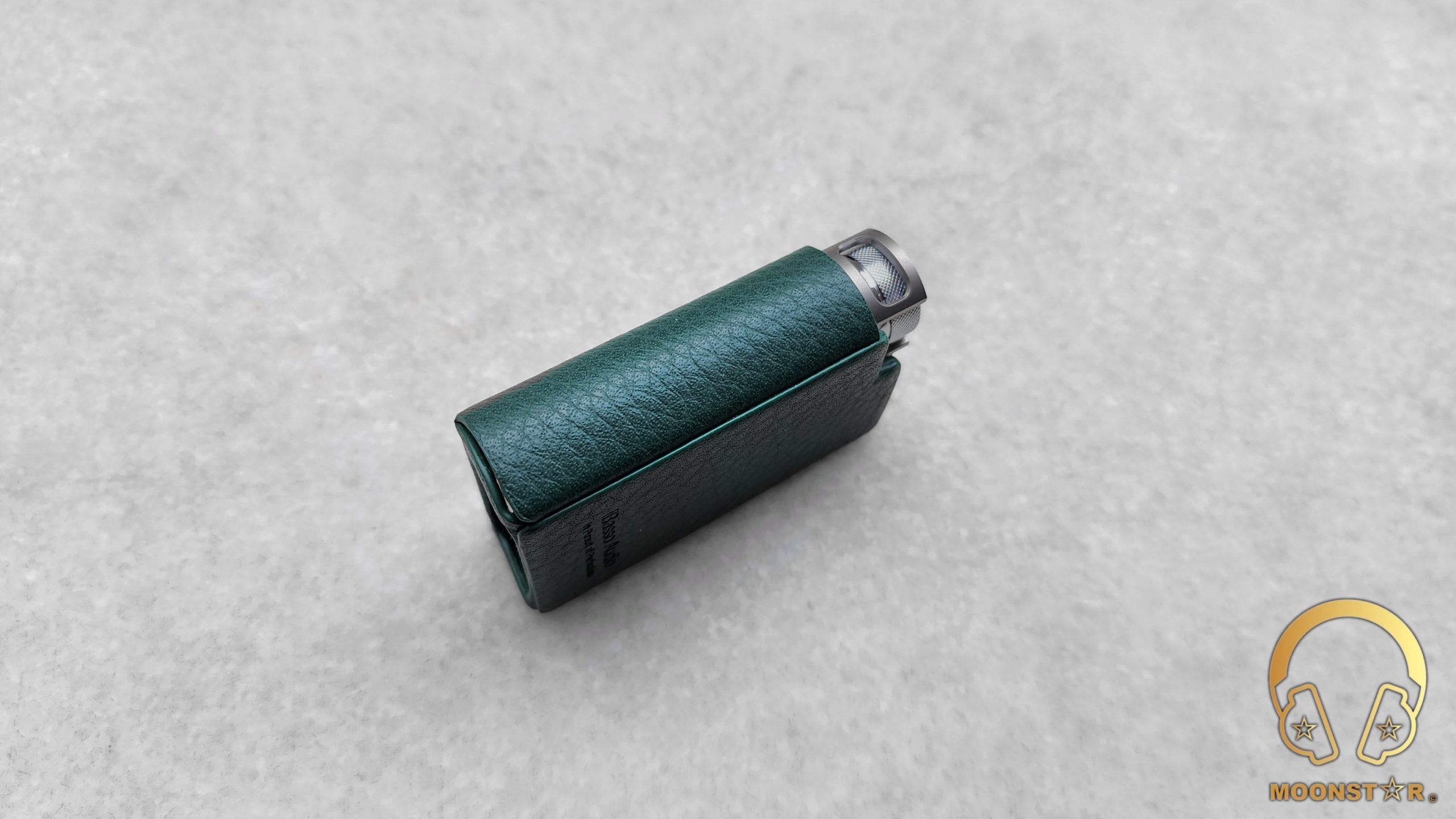
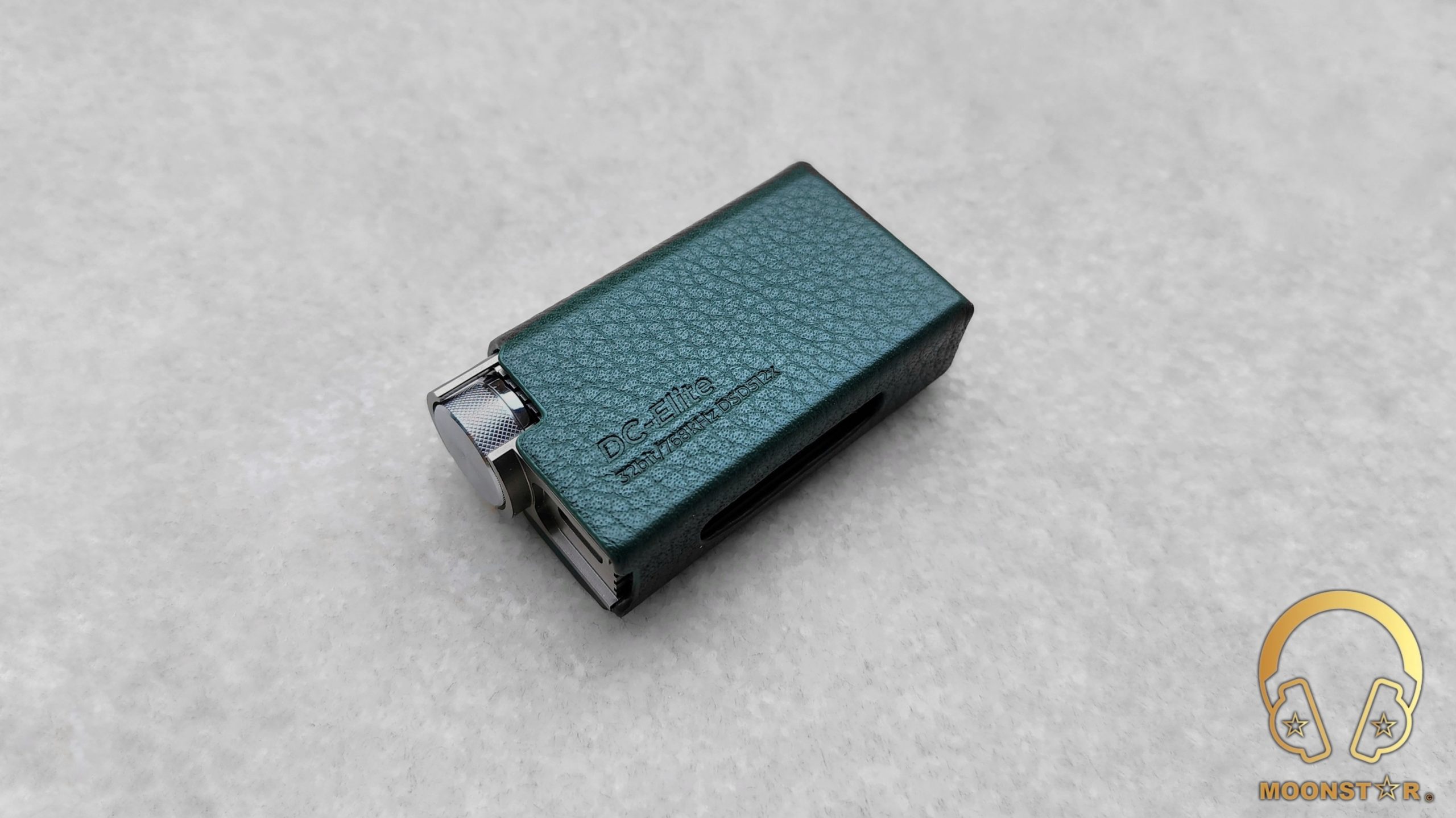
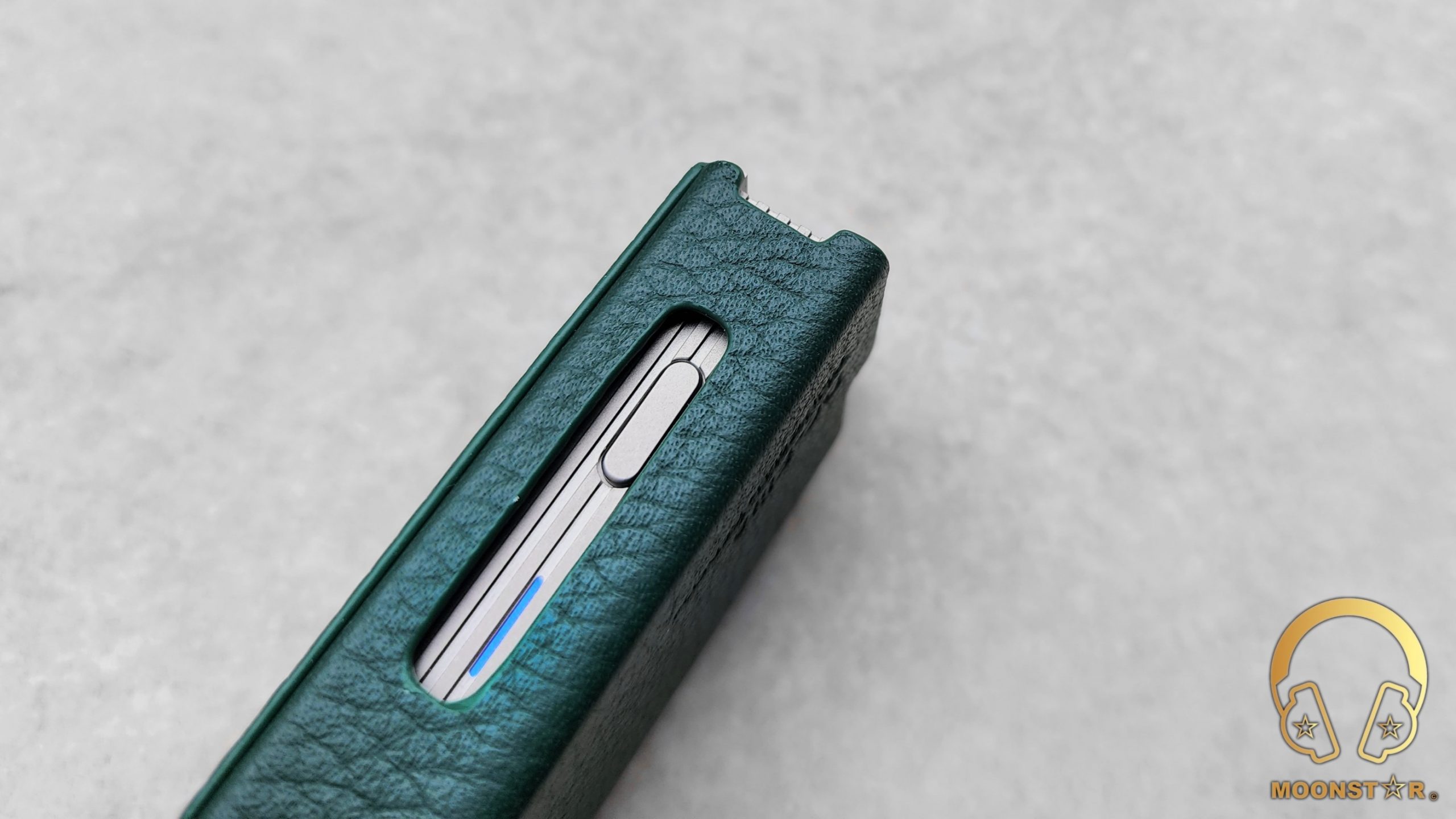
Design & Build Quality:
From the first encounter, the iBasso DC-Elite leaves an indelible impression with its meticulously crafted design. The chassis, made from premium titanium alloy, and the tempered glass panels on the front and rear exudes an air of sophistication and durability. Titanium has the best strength-to-weight ratio among all metals, being lighter than stainless steel and stronger than aluminum alloys. The intuitive placement of the volume control demonstrates a thoughtful ergonomic approach, ensuring both functionality and aesthetic appeal. The attention to detail in the construction of the DC-Elite is a testament to iBasso’s commitment to creating an flagship grade device that not only sounds exceptional but also feels like a piece of sonic art.
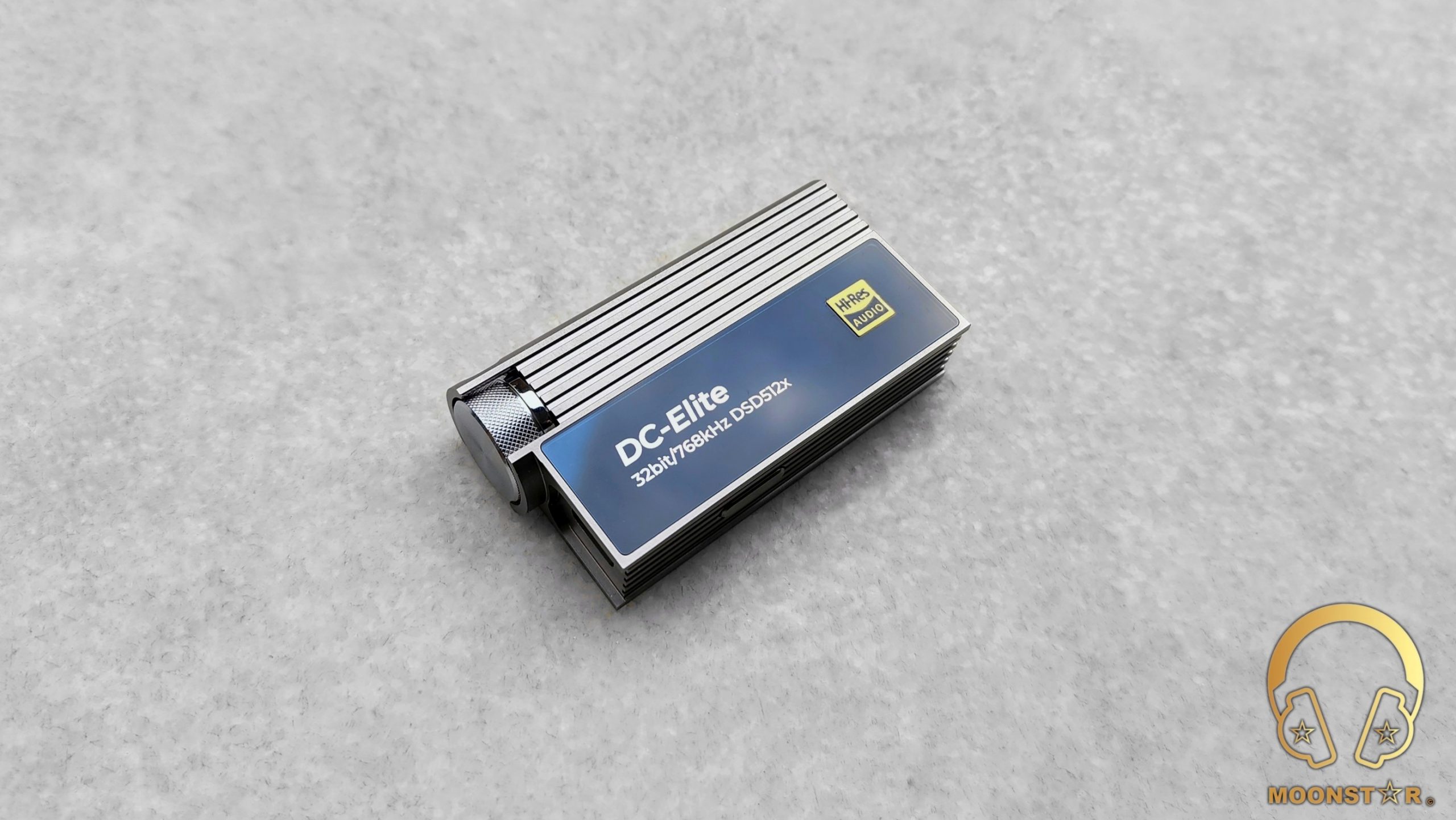
The DC-Elite is a pretty compact device with dimensions of 64mm x 35mm x 14.5mm that weights approx 60.5g.
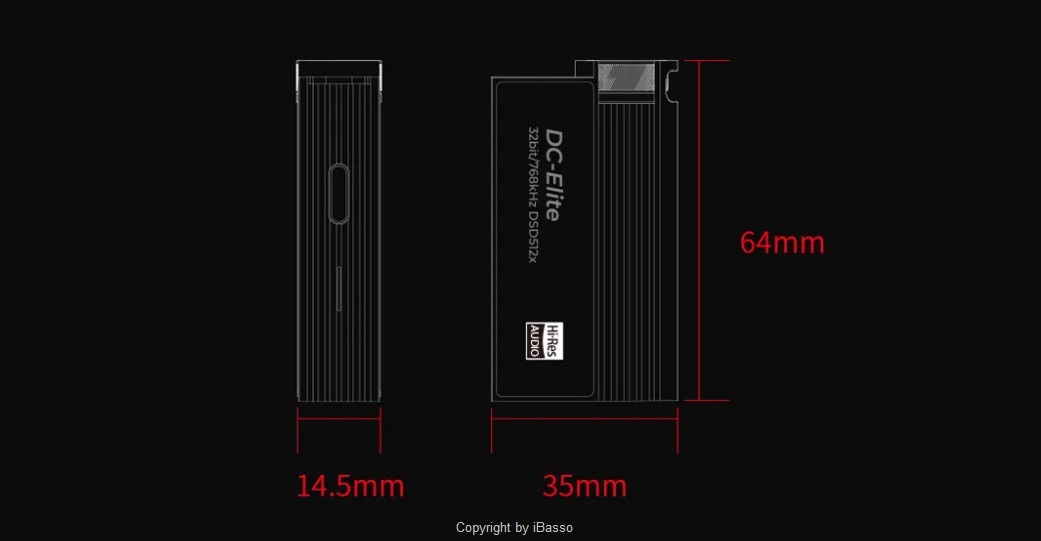
The left front face features a tempered glass surface with a blue tint that displays the DC-Elite logo and the supported audio resolutions of 32-Bit/768kHz/DSD512x, while a small label certifies that it is Hi-Res Audio compatible.
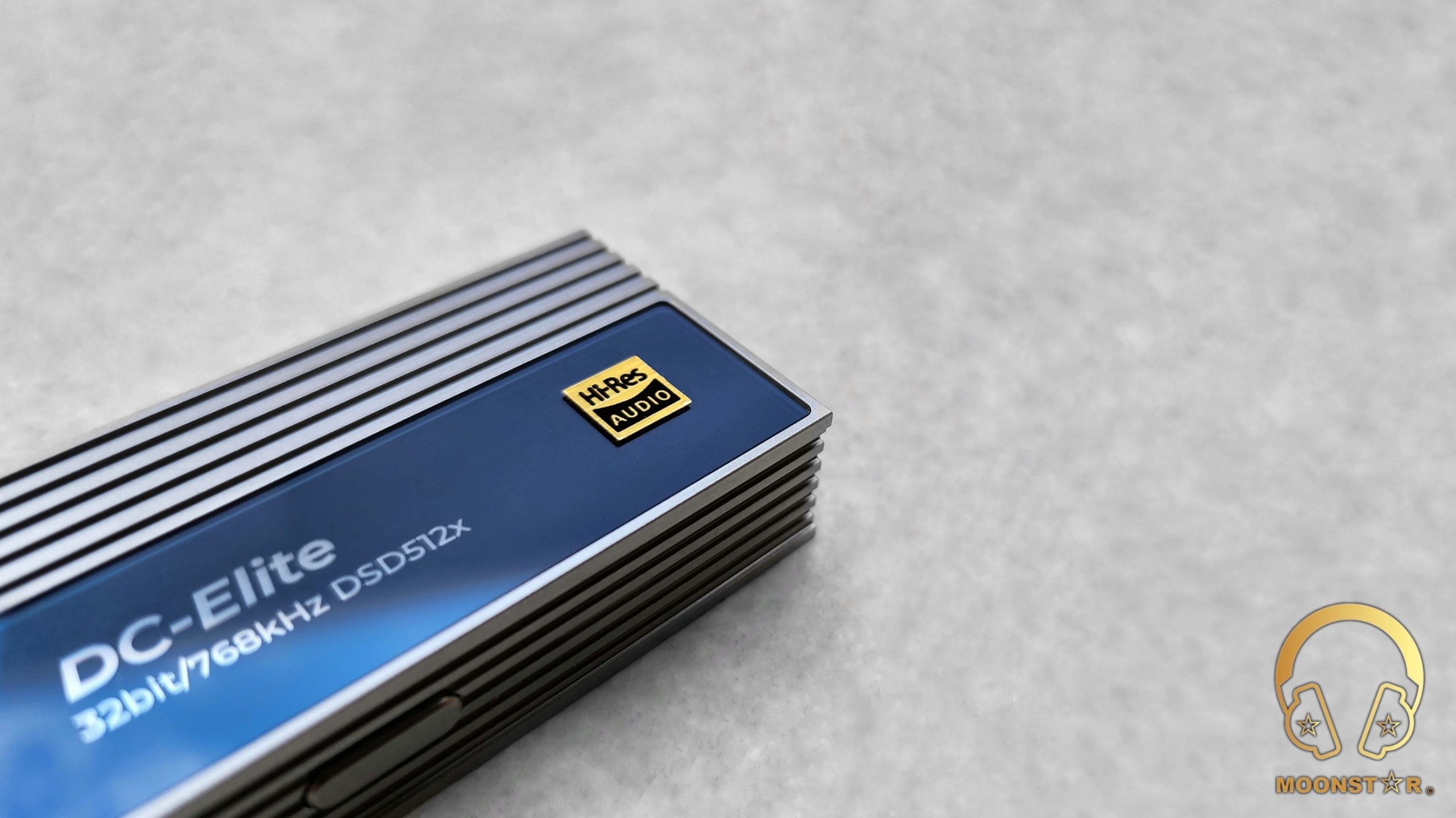
Next to this, on the right side of the same face, a thin ribbed surface adds texture and visual interest to the device’s design. This feature is reminiscent of vintage car stereo amplifiers and is one of the main design elements that characterize the iBasso DC-Elite’s aesthetic appeal.
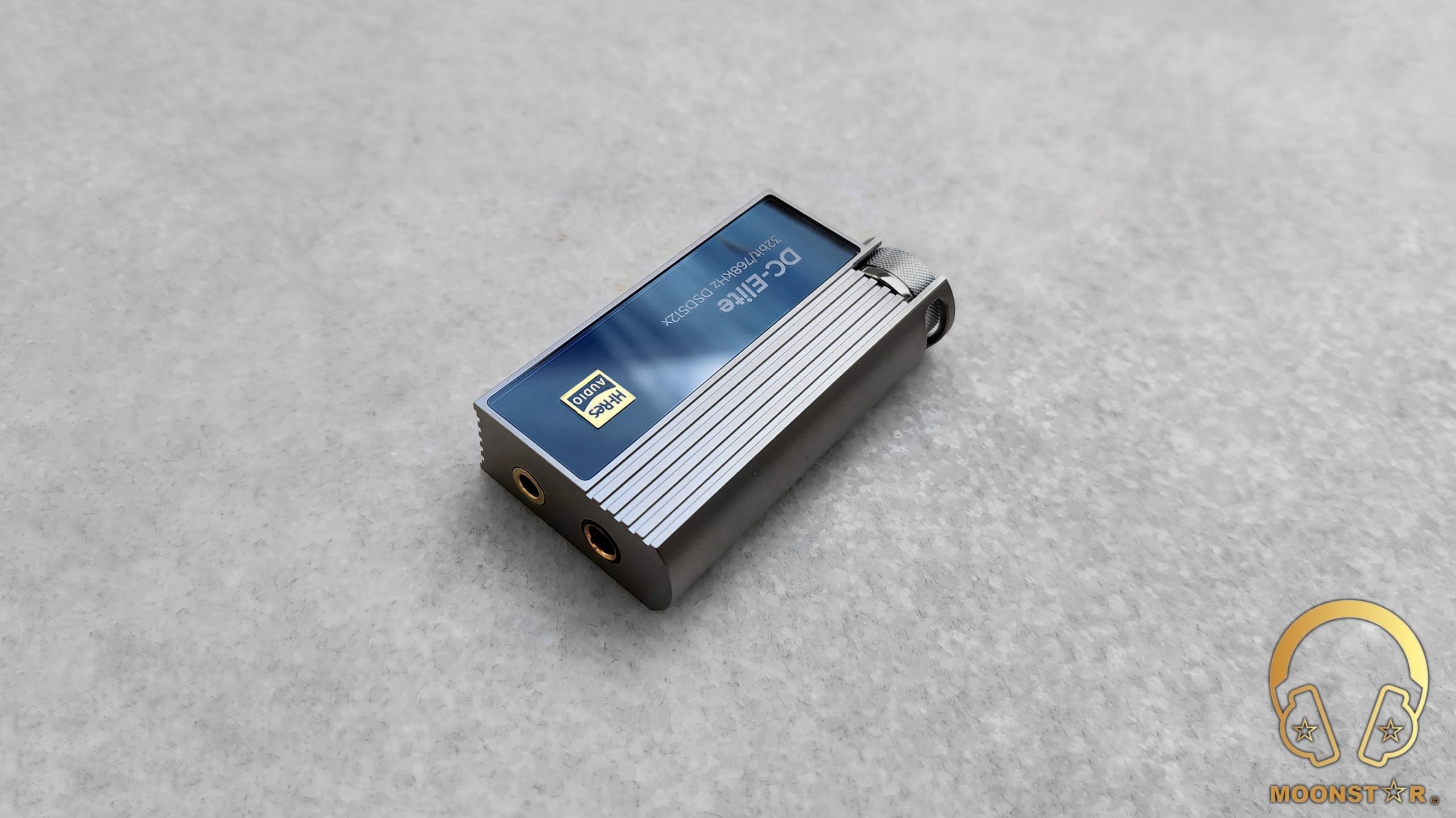
The right surface has a smooth, rounded shape that complements the robust appearance of the device.
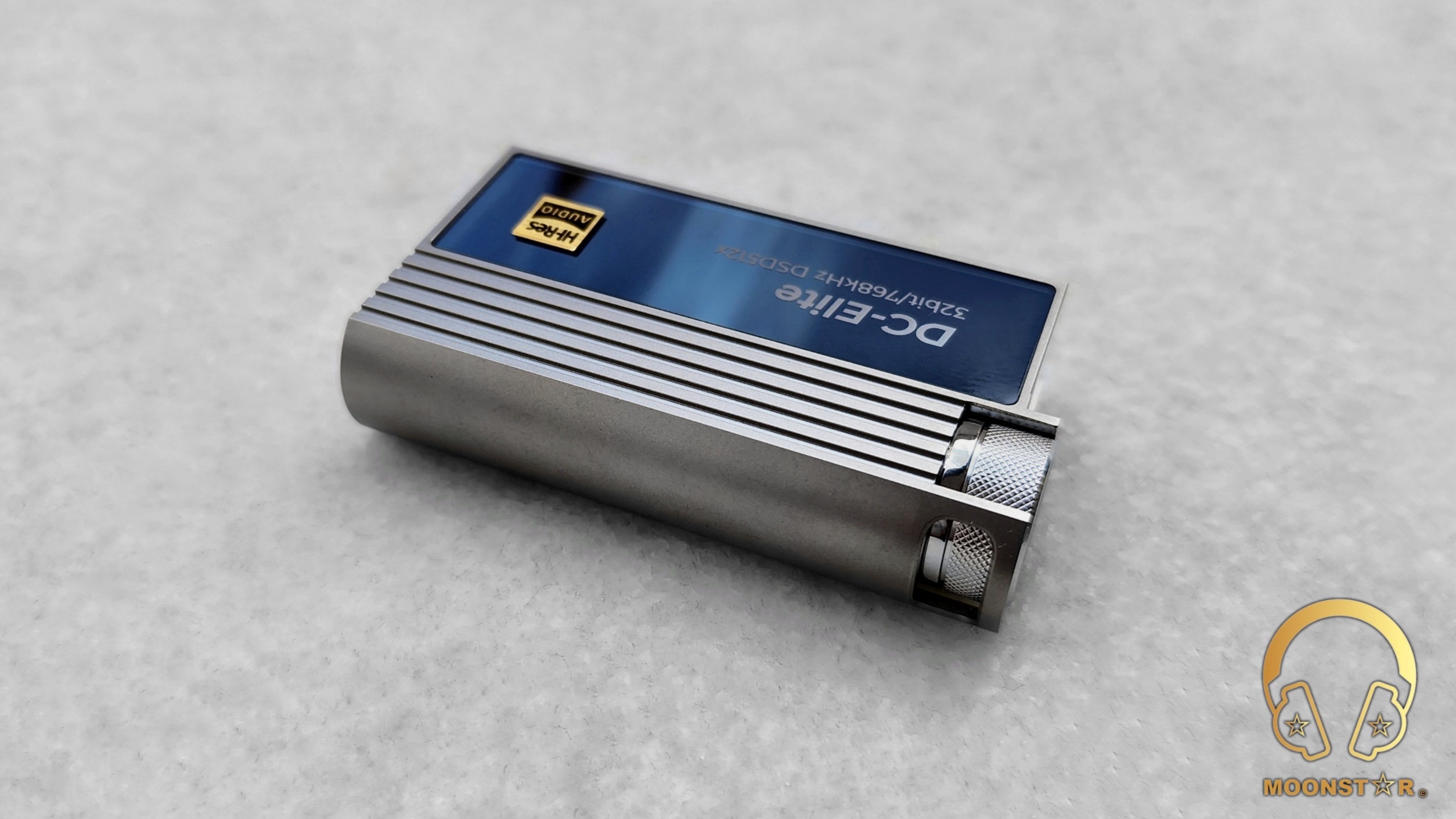
Mirroring the front, the left surface of the DC-Elite boasts the same vintage design. Additionally, it houses a multi-colored LED status indicator. This indicator glows red in standby mode, blue for DSD, green for PCM rendering, and white when using coaxial output.
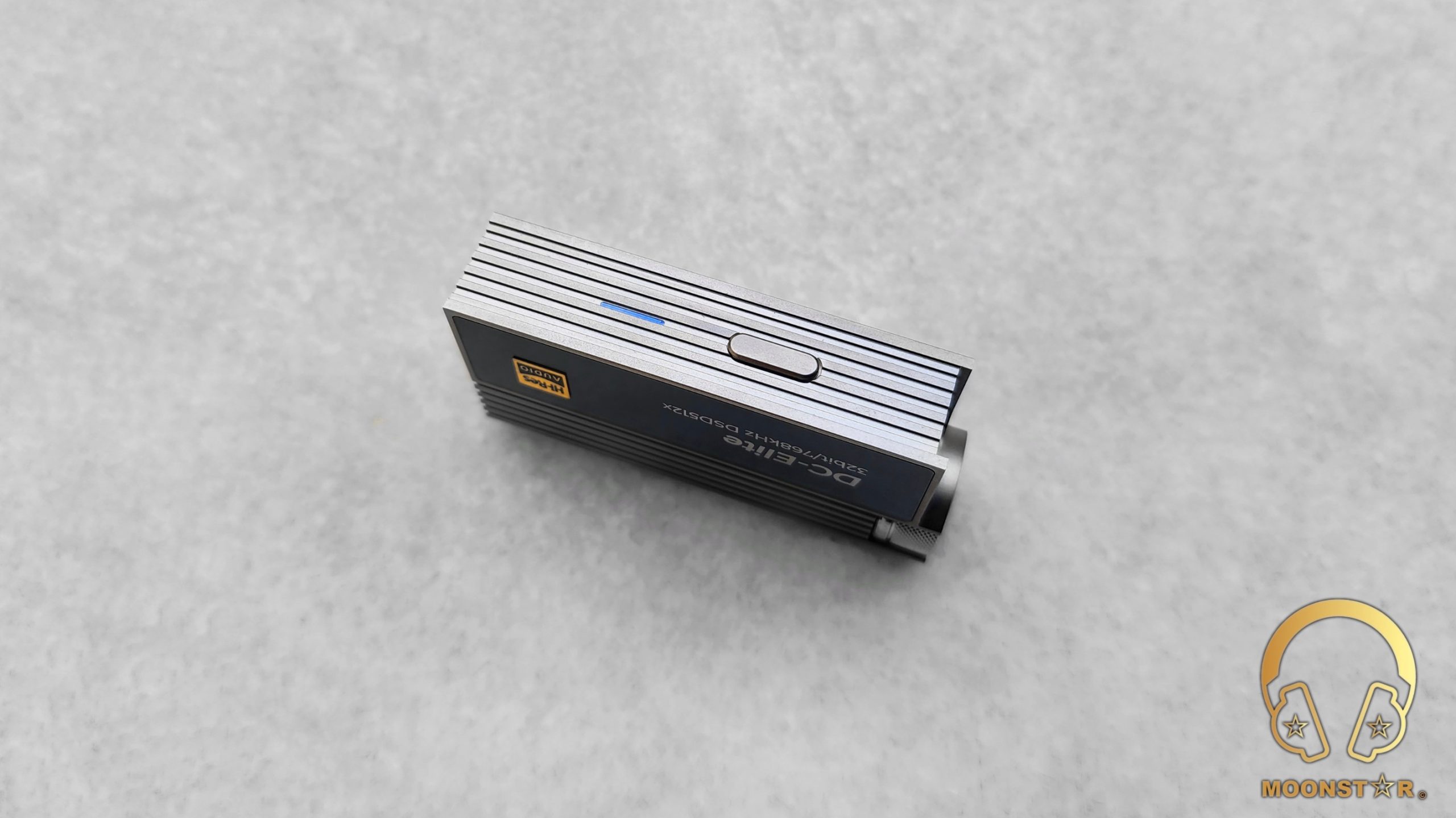
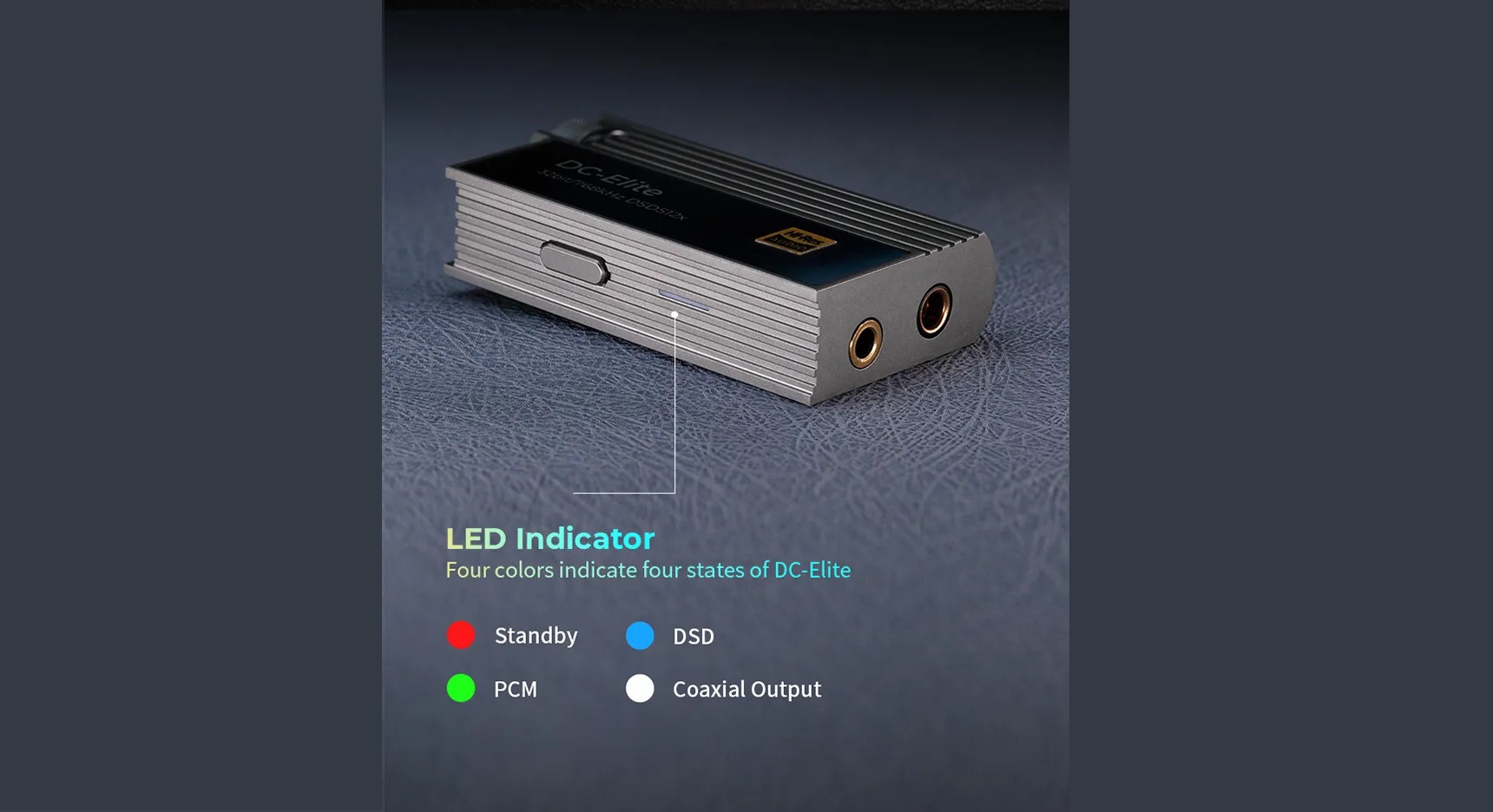
Here is also a physical 4-step PCM volume reduction button.
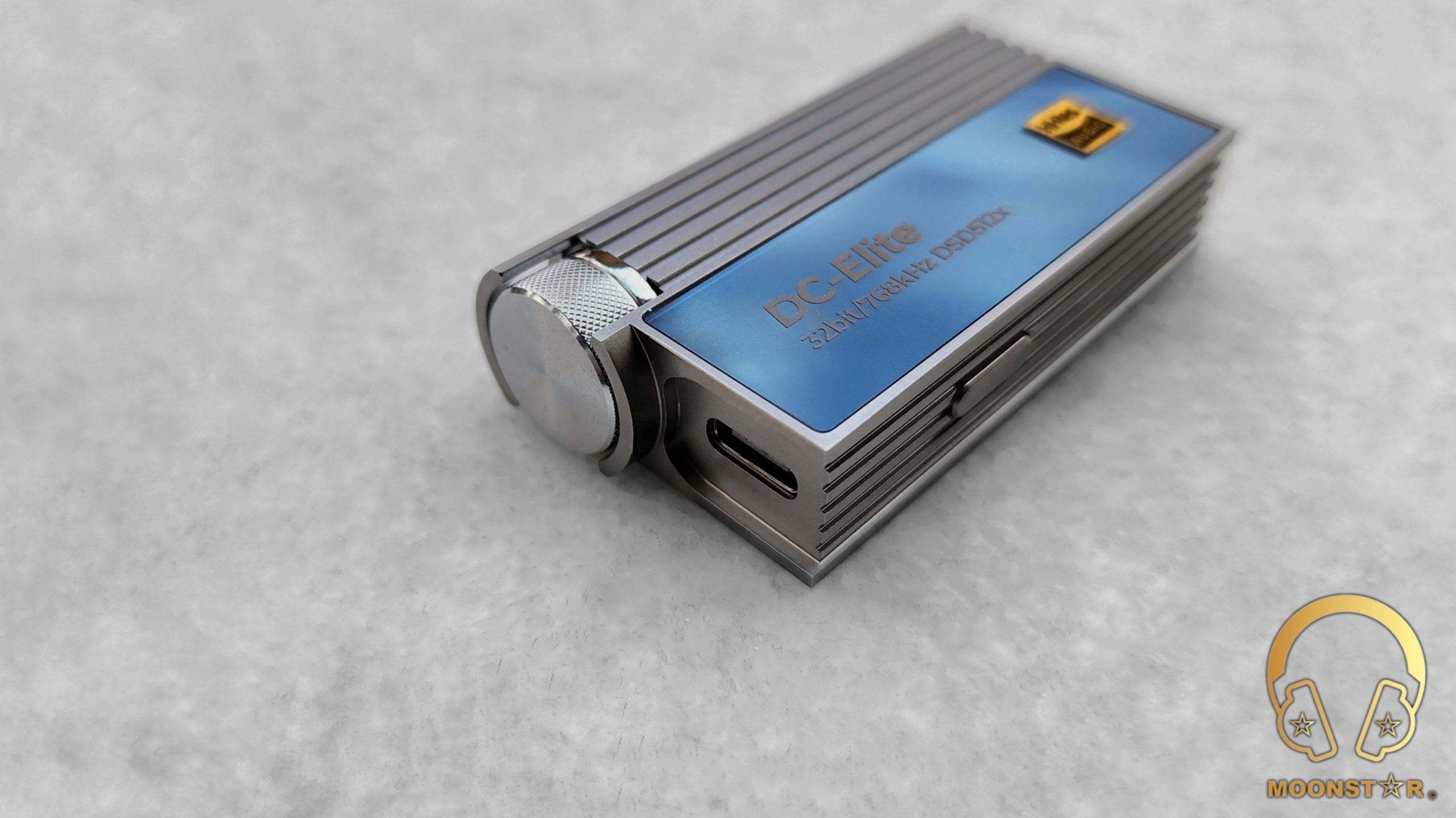
On the top of the device are the USB Type-C port data/power port and a true stepped attenuator for volume control. It’s the same high quality stepped attenuator that was used on the DX320MAX. It is a true high quality attenuator that offers a better performance compared to regular conductive plastic or other type of volume controls.
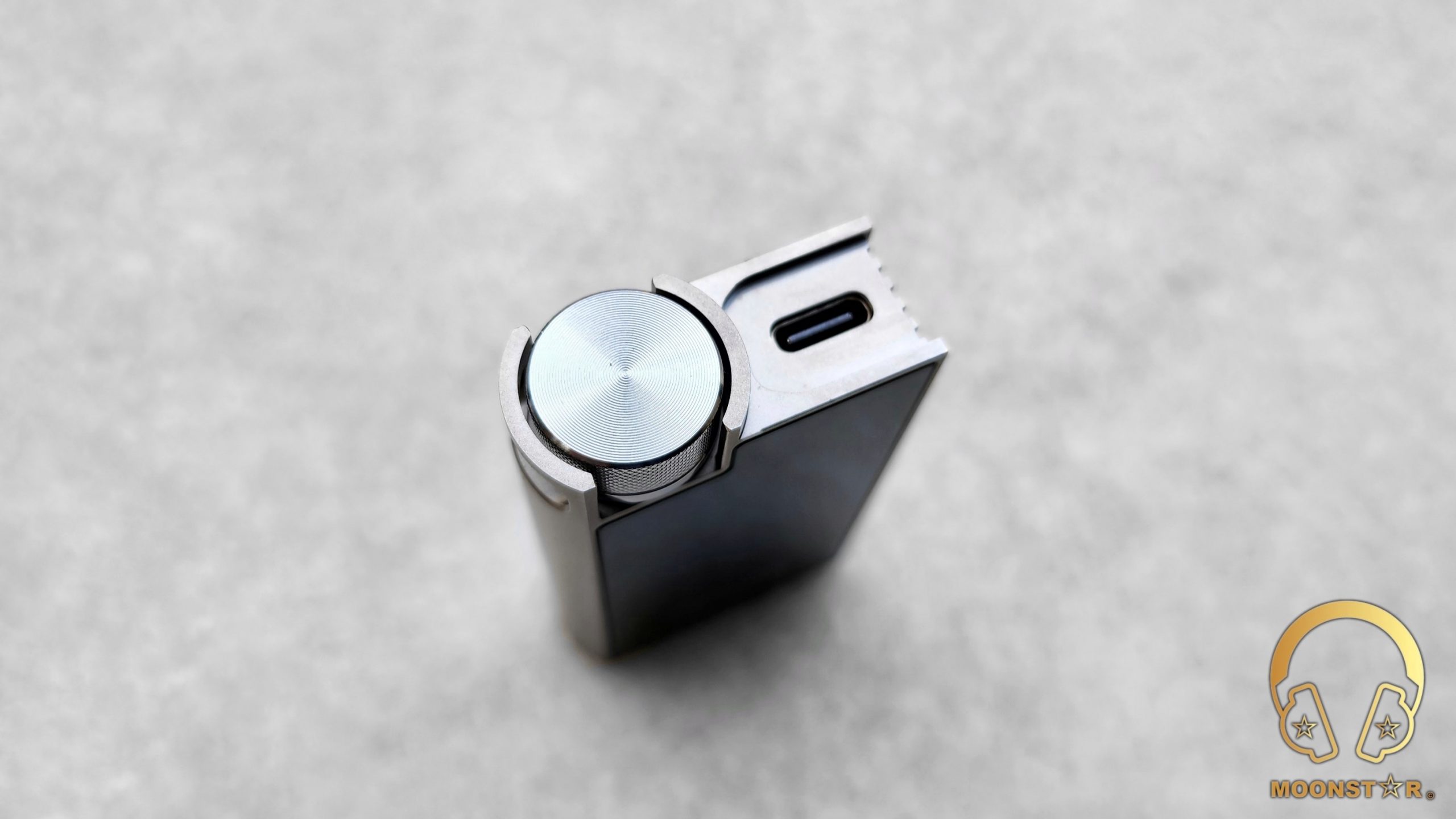
This aesthetically pleasing volume wheel, equipped with a stepped attenuator, is shielded from external impacts by protrusions on either side.
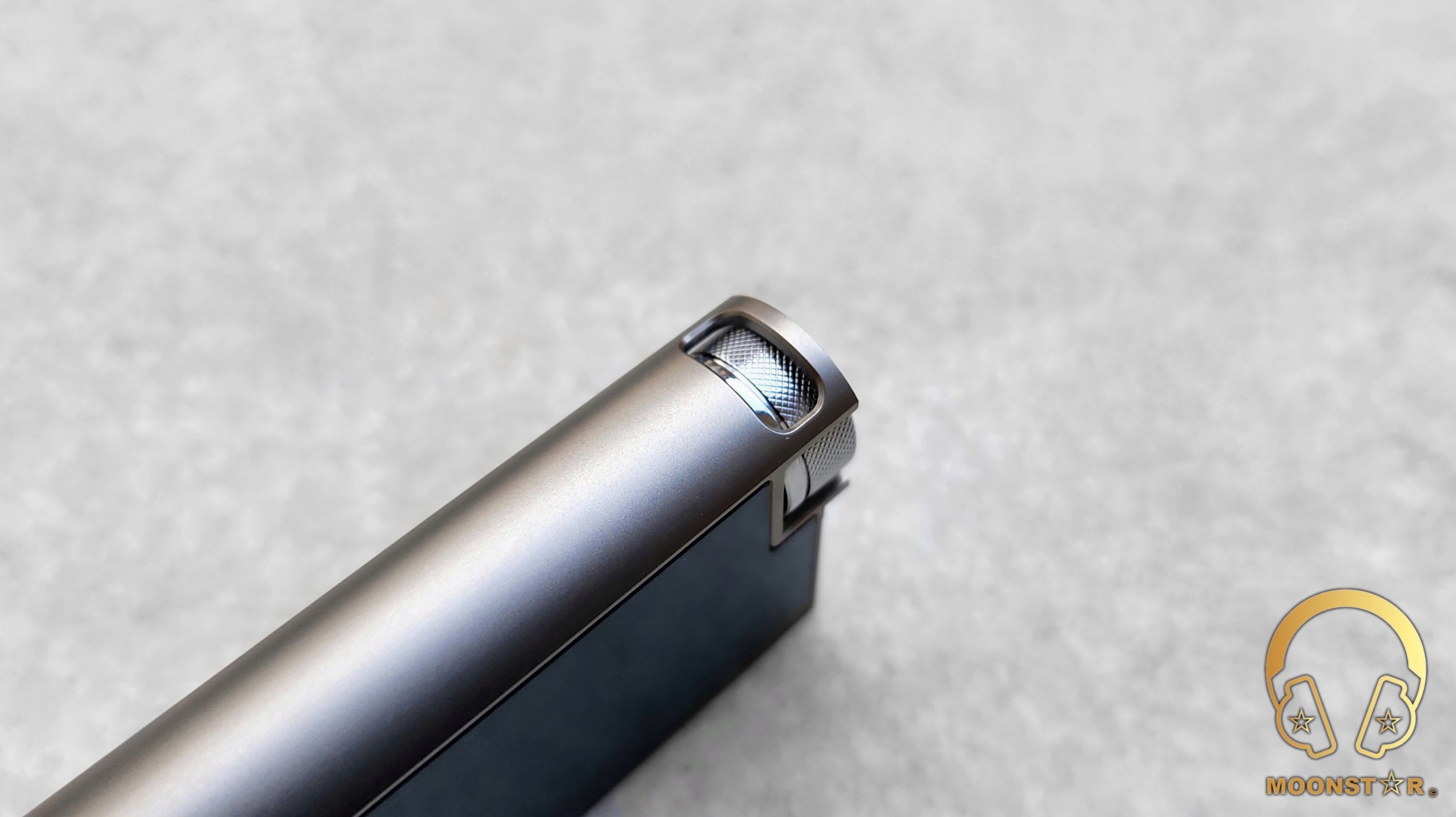
The rear side of the device boasts a second tempered glass surface, where the iBasso Audio branding is displayed alongside their inspirational phrase, “In Pursuit of Perfection”.
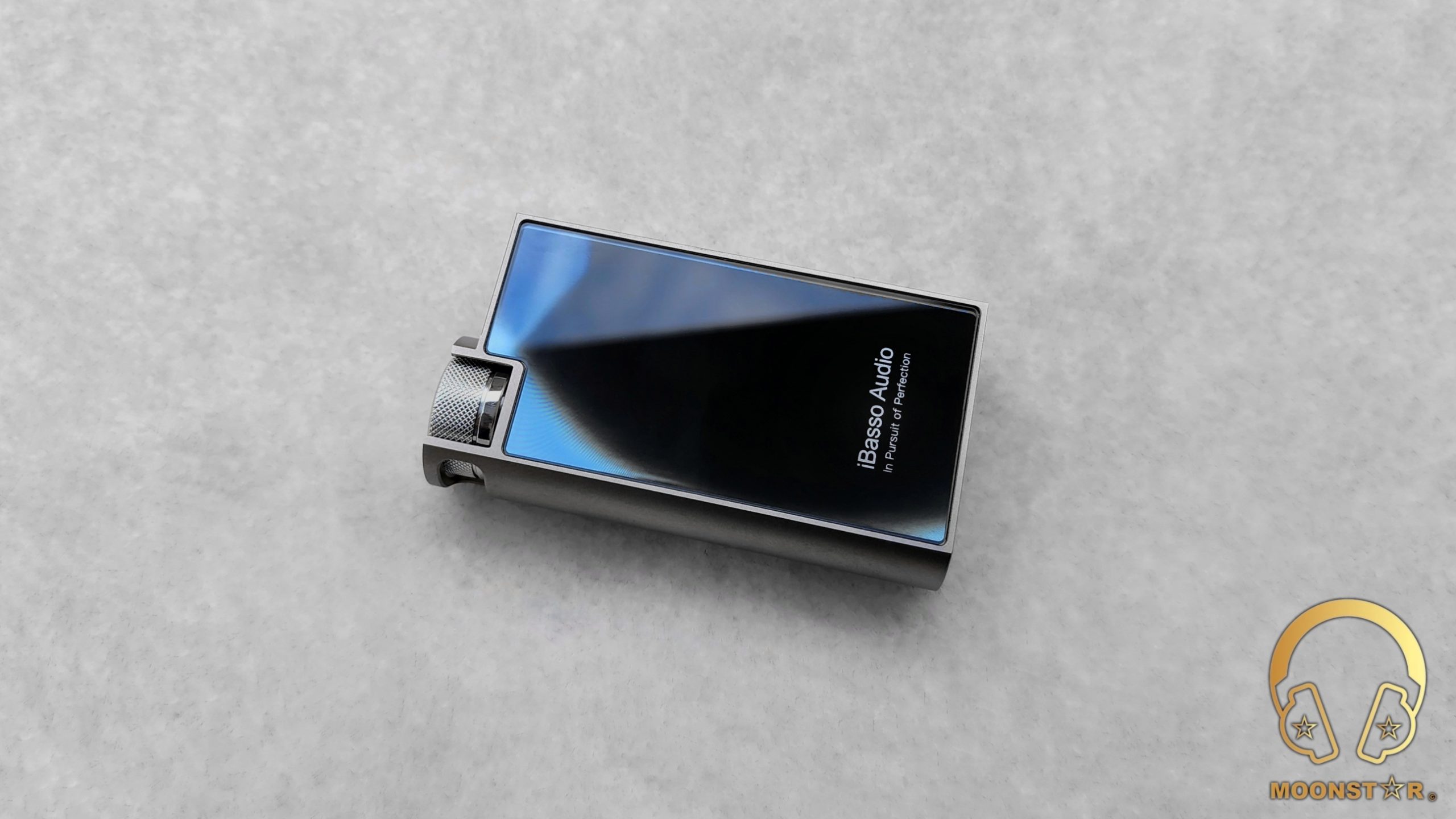
At the bottom of the device are the 4.4mm Balanced and 3.5mm Single Ended analog outputs. A long press of the PCM volume reduction button turns the 3.5mm output in to a Coaxial/SPDIF output port.
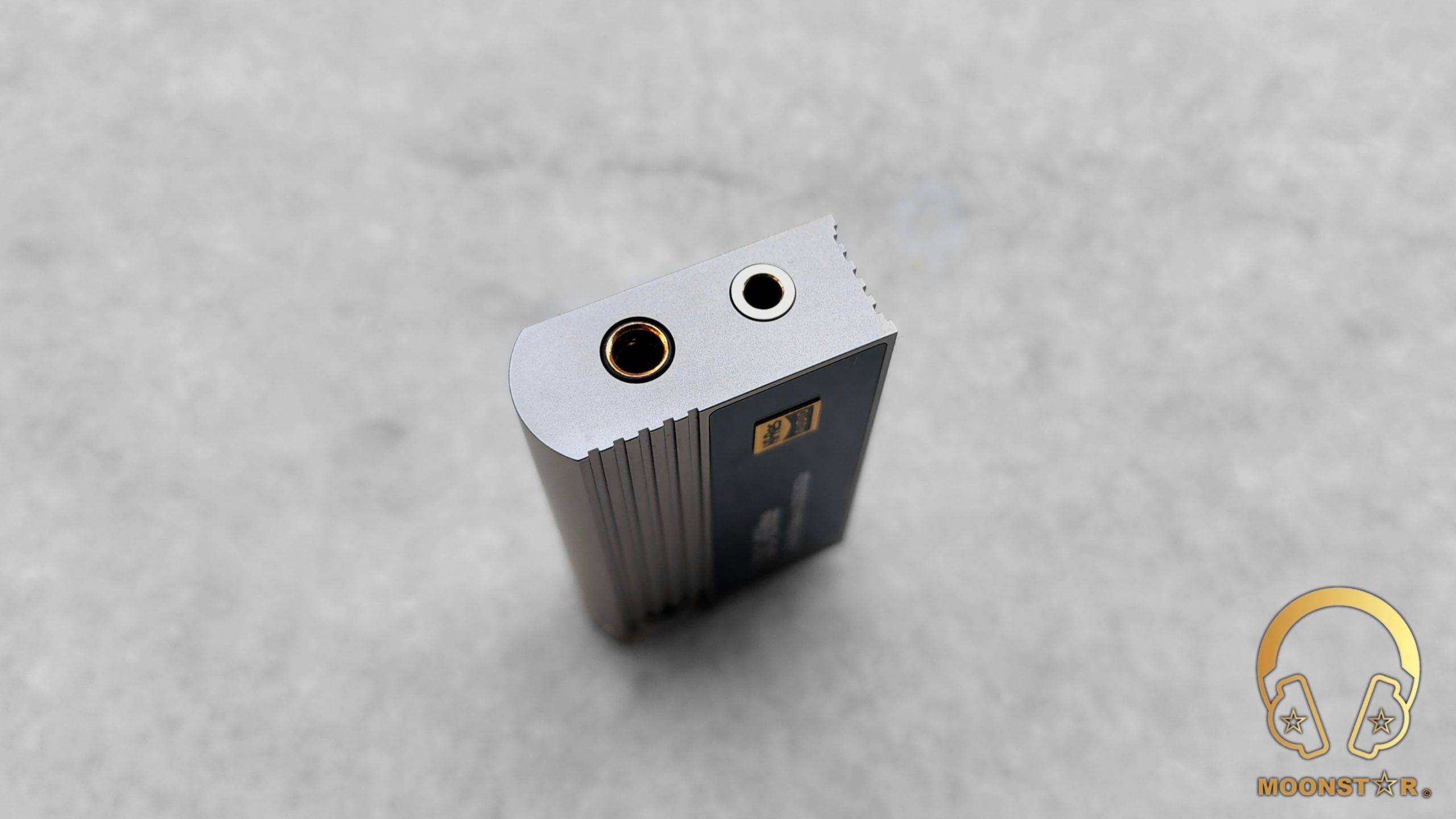
Technical Specifications:
- DAC Chipset : ROHM B034301EKV
- PCM : up to 32bit/768kHz
- DSD : Native DSD64, DSD128, DSD256, DSD512
- Coaxial Out : Up to 32bit/768kHz
- Weight : 60.5 g
- Size : 64mm X 35mm X 14.5mm
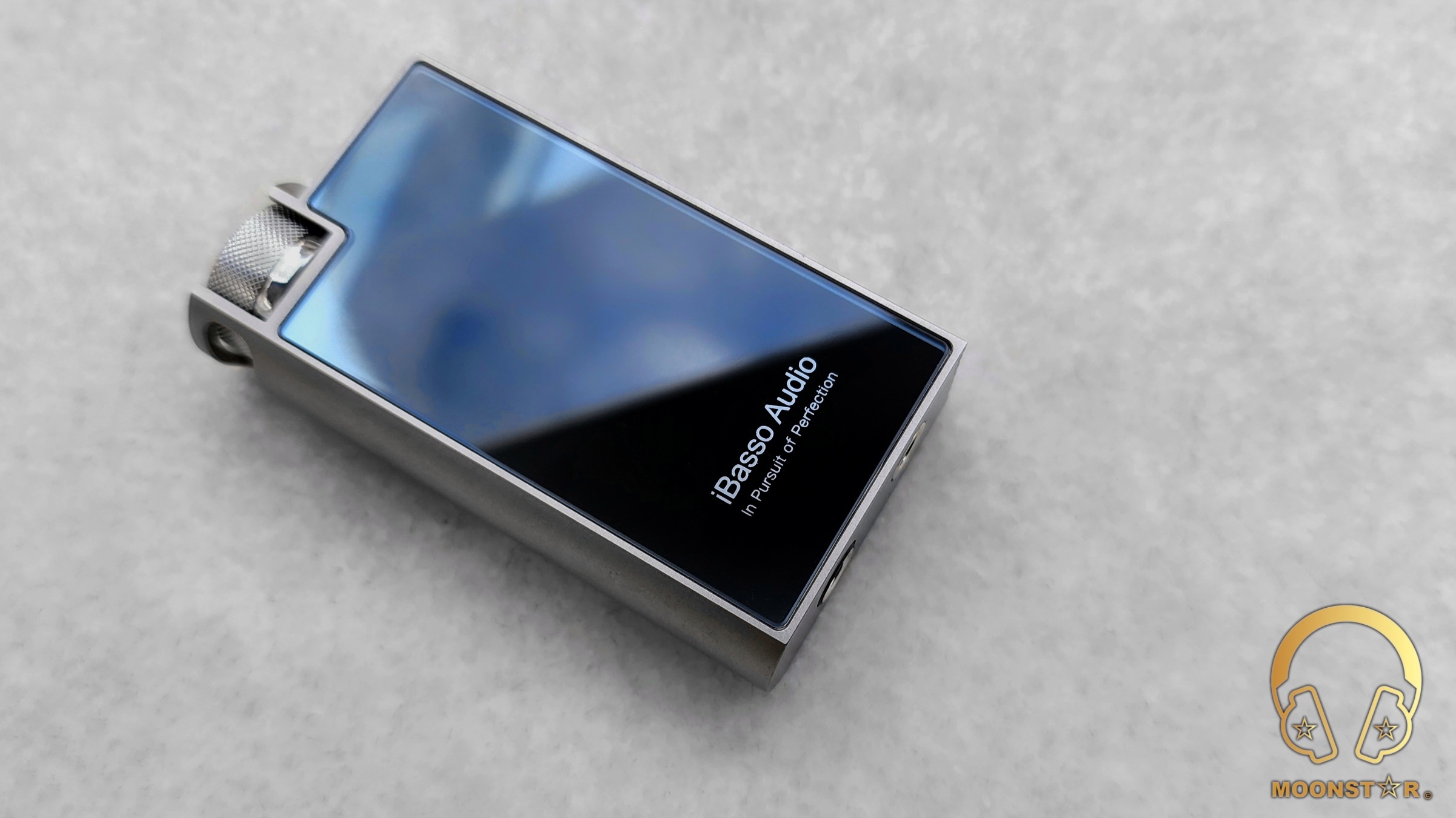
4.4mm Balanced Output
- Output Voltage: 4.6Vrms
- Output Power: 280mW@32Ω, 70mW@300Ω
- THD+N: 0.00022% (300Ω load) 0.00031% (32Ω load)
- Frequency Response: 10Hz-50kHz -0.5dB
- S/N: 121dB
- Dynamic Range: 118dB
- Noise Floor: 3.5µVrms (Normal listening volume: 0.9µV)
- Output Impedance: <0.4Ω
3.5mm Single-ended Output
- Output Voltage: 2.28Vrms
- Output Power: 162mW@32Ω
- THD+N: 0.00028% (300Ω load) 0.00055% (32Ω load)
- Frequency Response: 10Hz-50kHz -0.5dB
- S/N: 117dB
- Dynamic Range: 115dB
- Noise Floor: 2.4µVrms (Normal listening volume: 0.8µV)
- Output Impedance: 0.2Ω
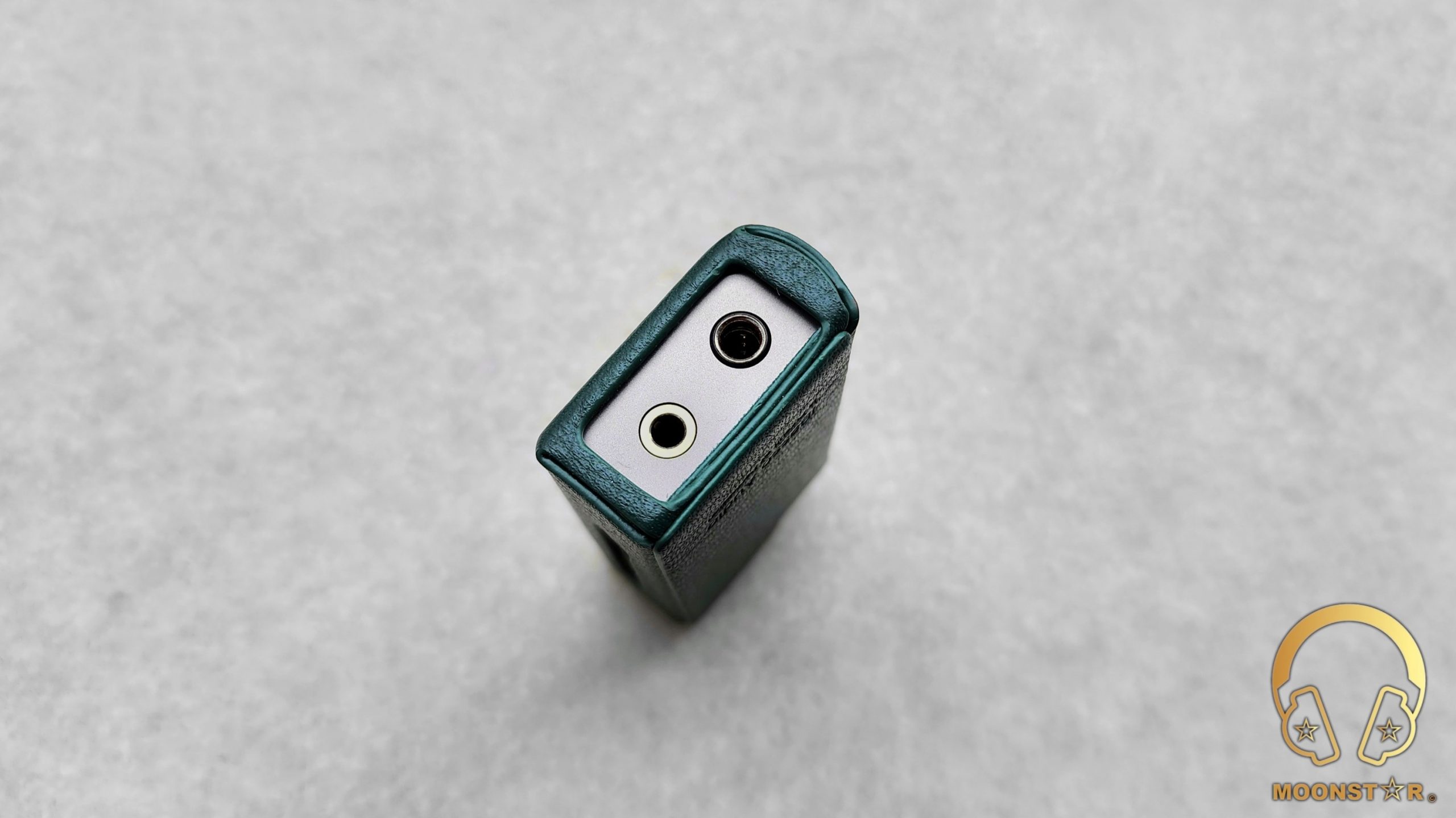
Hardware & Software Features:
Inside its compact frame, the DC-Elite packs a punch: a ROHM DAC for pristine audio, a 4-section stepped attenuator for precise control, and dual OPAMPs for robust power. Plus, it handles DSD512x and PCM 768kHz for high-resolution playback.
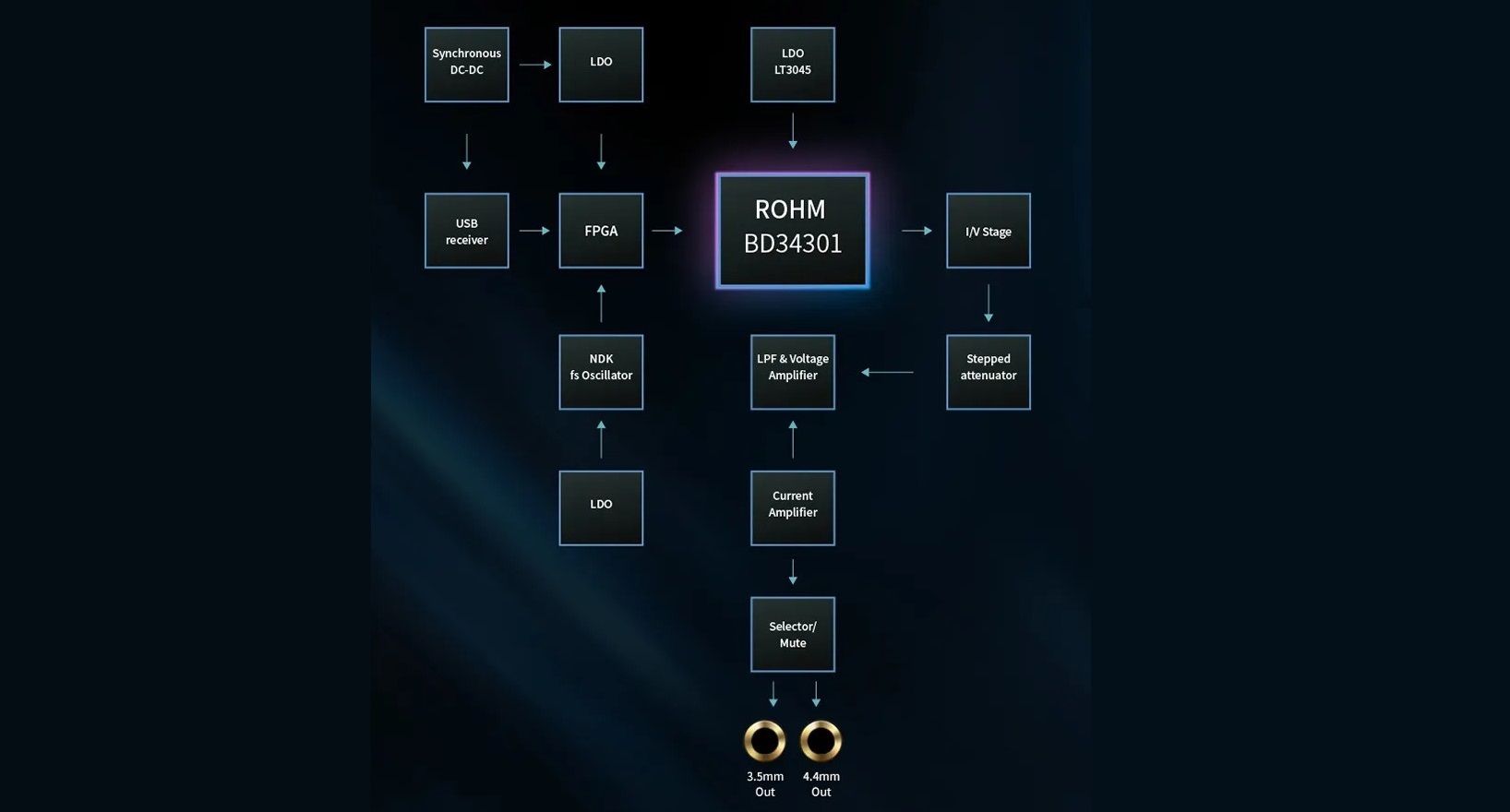
Digital to Analog Converter & Amplification:
The iBasso DC-Elite is the first USB DAC/AMP dongle that features a BD34301EKV DAC Chip of the Japanese company ROHM. This flagship current-output DAC offers an impressive performance in combination with all the other hardware parts resulting in a decent THD+N value of 0.00022% @ 300Ω load and 0.00031% @ 32Ω, and a SNR of 121dB over the 4.4mm Balanced output.
“The iBasso DC-Elite is a powerhouse portable USB DAC/Amplifier dongle, capable of driving demanding headphones like the HiFiMAN Edition XS. It delivers up to 280mW @ 32Ω, ideal for dynamic in-ears, and 70mW @ 300Ω for high-impedance over-ears, all through the balanced 4.4mm output. But the true star of the show is the incredibly dark background and silent noise floor, which was audible with sensitive IEM’s like the Campfire Audio Solaris Stellar Horizon. This translates to a pristine soundscape, devoid of any unwanted hiss or noise, allowing you to hear every nuance of your music with breathtaking clarity.”
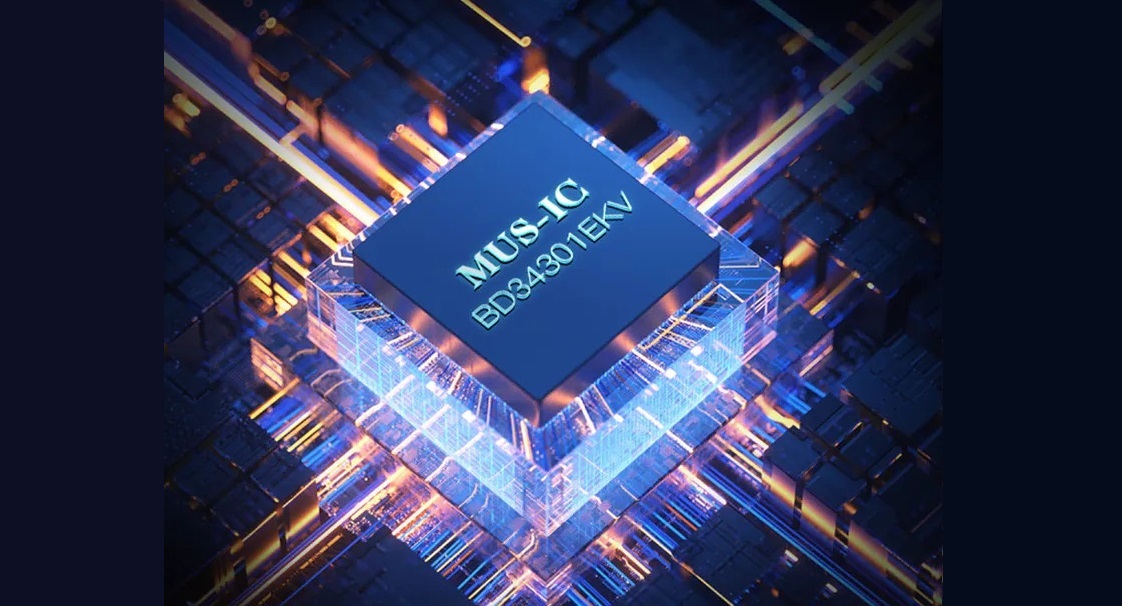
The DC-Elite boasts a complete player architecture, following the FPGA->DAC->I/V->LPF->VOL->AMP signal path. This high-end design sets it apart from the competition, featuring 6 dual OPAMPs and the flagship DAC chip BD34301EKV. Further enhancing its performance, the DC-Elite leverages its in-house developed FPGA algorithm and an NDK femtosecond oscillator. This combination minimizes jitter, resulting in minimal distortion and a significant improvement in overall sound quality.

Supported Sampling Rates:
The iBasso DC-Elite support sampling rates from 16, 24, 32Bit, 44.1, 48, 88.2, 96, 176.4, 192, 352.8, 384kHz, 768kHz up to Native DSD 512x.

Power Supply Technologies & Power Consumption Control:
Beyond a high-efficiency power supply with a synchronous DC-DC converter, the DC-Elite boasts ultra-low noise LDOs from Linear Technology, previously used for flagship audio players. This remarkable internal design delivers impressive power efficiency despite its desktop-grade flagship DAC and complete player architecture, which offering it an advantage over other products.
More about the 24 position 4-Section Stepped Volume Attenuator:
The iBasso DC-Elite miniaturizes the traditional 24-position, 4-section stepped attenuator to a remarkably compact size, while maintaining precise left-right channel balance (below 0.1dB) and consistent performance. This design, identical to the one used in the flagship DX320 Max, offers seamless volume control and exceptional channel accuracy. The device itself boasts a solid build and premium finish, thanks to its CNC-machined titanium alloy chassis. Titanium’s inherent strength ensures robustness, a luxurious feel, and solid durability.
At normal volume with a 32-ohm load (approximately 50mV-100mV output), the DC-Elite boasts a remarkable Signal-to-Noise Ratio (SNR) of approximately 96.3dBA. This means the music signal is exceptionally clear, with minimal background noise, even at moderate volume levels. This SNR significantly surpasses industry standards for portable DAC/amps and sets a new benchmark for audio fidelity on the go.
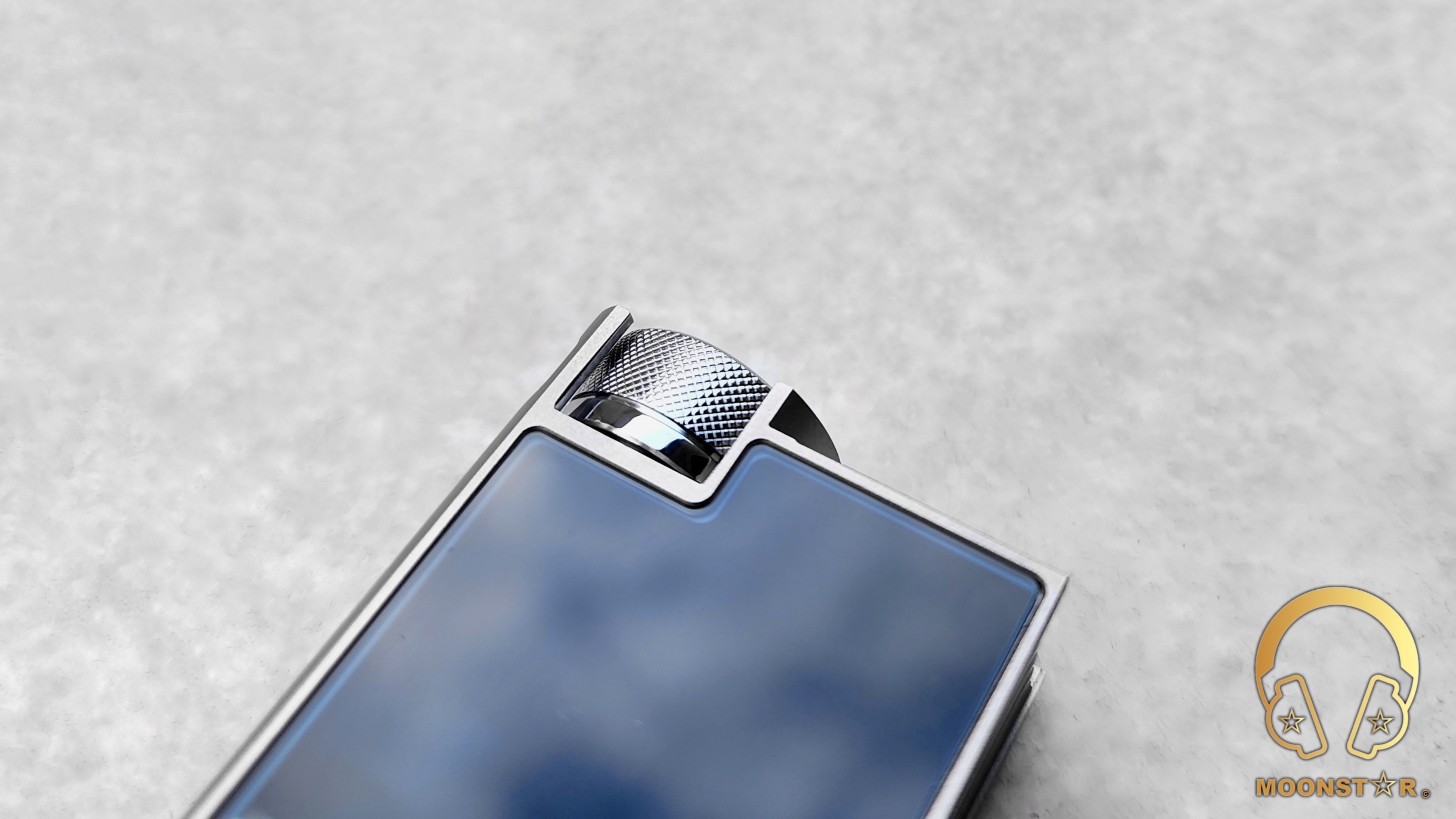
Connectivity:
The iBasso DC-Elite uses a versatile USB Type-C connector and the standard UAC2.0 USB receiver, making it compatible with most Android smartphones (5.1 and above) and tablets. It also functions as a USB sound card for Mac and Windows PCs when connected with the included USB Type-C to USB-A adapter. Moreover, the DC-Elite extends its reach to Apple iOS devices like iPhones and iPads through the provided USB Type-C to Lightning cable.
Tips for optimal use:
- On Android devices, manually enabling the OTG function in system settings may be necessary.
- For enhanced control and customization, download the iBasso UAC app while using Android devices.
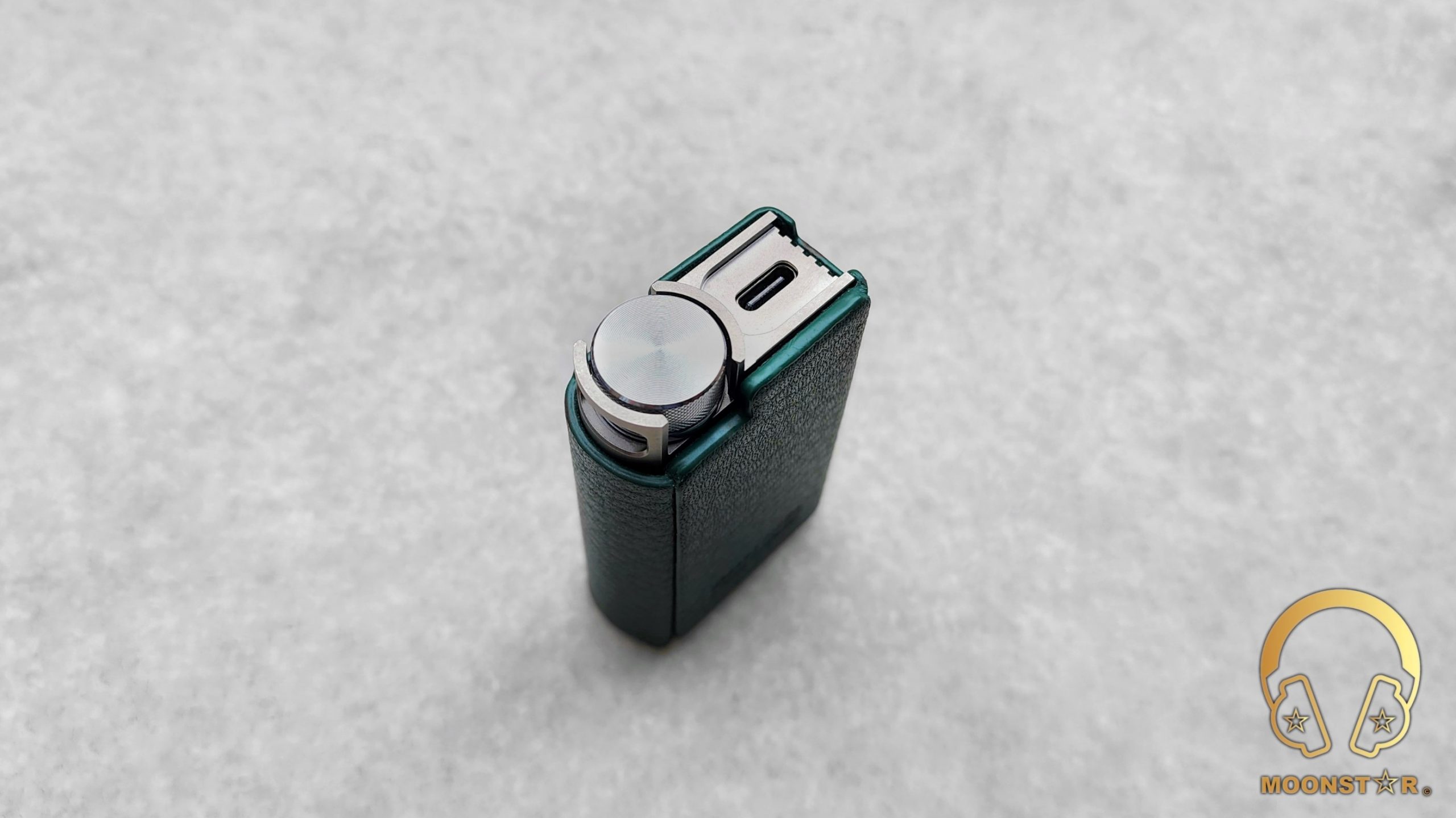
UAC Application:
The DC-Elite supports the iBasso UAC2.0 app, offering advanced customization options like digital filters (D1 and D2 for optimizing sound characteristics), fine-grained PCM volume control with 1dB increments, DSD filtering, PCM/DSD volume matching, Coaxial/SPDIF mode switching, 20 levels of L/R channel balance. Please note that the Google Play Store app is not compatible with the DC-Elite. Instead, download the dedicated app from iBasso’s official website for optimal functionality.
- Here is the link to the UAC for the Elite: https://ibasso.com/dc-elite-driver-fw-app/

Equipments used for this review:
- DAC’s : iBasso DC-Elite, Cayin RU7
- USB Source : Samsung Galaxy S22 Ultra, Asus TUF FX505DU
- IEM’s : iBasso IT07, Campfire Audio Supermoon, Meze Audio RAI Penta
- Headphones : iBasso SR02

Albums & tracks used for this review:
- Adele – My Little Love (Spotify)
- Randy Crawford – On Day I Will Fly Away (Flac 16bit/44.1kHz)
- Hayley Westenra – Odyssey Album (Dezzer HiFi)
- Dionne Warwick – Walk On By (Flac 16bit/44.1kHz)
- Sarah McLachlan – Angel (Flac 24bit/48kHz)
- Sertap Erener – Aşk (Flac 16bit/44.1kHz)
- Edith Piaf – Non Je Ne Regrette Rien (Flac 16bit/44.1kHz)
- Diana Krall – So Wonderful (DSF)
- Aretha Franklin – I Say A Little Payer (Flac 24bit/96kHz)
- Sonya Yoncheva – (Giuseppe Verdi) II Trovatore, ActI (Flac 24bit/96kHz)
- George Michael – Don’t Let the Sun Go Down on Me (Flac 24bit/192kHz)
- David Bowie – Heroes (Flac 24bit/192kHz)
- Elton John – Rocket Man ((Flac 24bit/96kHz)
- Barry White – Just The Way You Are (Flac 24bit/48kHz)
- Isaac Hayes – Walk On By (Flac 16bit/44.1kHz)
- Sting – Englishman in New York – (Flac 24bit/48kHz)
- Eric Clapton – Wonderful Tonight (Flac 24bit/96kHz)
- B. King – Riding With The King (Tidal Hi-Fi)
- Dave Gahan – Kingdom (Tidal Hi-Fi)
- U2 – Sunday Bloody Sunday (Flac 16bit/44.1kHz)
- Bro Safari, UFO! – Drama (Deezer HiFi)
- Armin Van Buuren – Vini Vici (Flac 16bit/44.1kHz)
- Daft Punk – Doin’ it Right (Flac 24bit/96kHz)
- Jo Blankenburg – Meraki (Spotify)
- Lorde – Royals (Flac 24bit/48kHz)
- Massive Attack – Angel (Flac 24bit/48kHz)
- Toutant – Rebirth (Deezer HiFi)
- Gogo Penguin – Raven (Flac 24bit/192kHz)
- Gogo Penguin – Murmuration (Flac 24bit/192kHz)
- Portishead – It Could Be Sweet (Spotify)
- Max Richter – On the Nature of Daylight (Flac 24bit/96kHz)
- Charly Antolini – Knock Out 2000 ”Album” (Flac 24bit/192kHz)
- Ferit Odman – Look, Stop & Listen (Flac 24bit/192kHz)
- Chopin – Nocturn No. 20 In C-Sharp Minor (Flac 16bit/44.1kHz)
- Fazıl Say – Nazım Oratoryosu (Live) (Flac 16bit/44.1kHz)
- Vivaldi – Le QuarttroStagioni “The Four Season” (Deezer HiFi)
- Otto Liebert& Luna Negra – The River (Flac 24bit/192kHz)
- Lunatic Soul – The Passage (Flac 16bit/44.1kHz)
- Deftones – My Own Summer (Shove it) (Flac 16bit/44.1kHz)
- Metallica – Sad but True (Flac 24bit/96kHz)
- Opeth – Windowpane (Flac 16bit/44.1kHz)
- Megadeth – Sweating Bullets (Tidal Hi-Fi)
- Rush’s – Leave That Thing Alone (Flac 16bit/44.1kHz)
- Slayer – Angel of Death (Spotify)
- Liquid Tension Experiment 2 – Acid Rain (Spotify)
- Yosi Horikawa – Bubbles (Spotify)
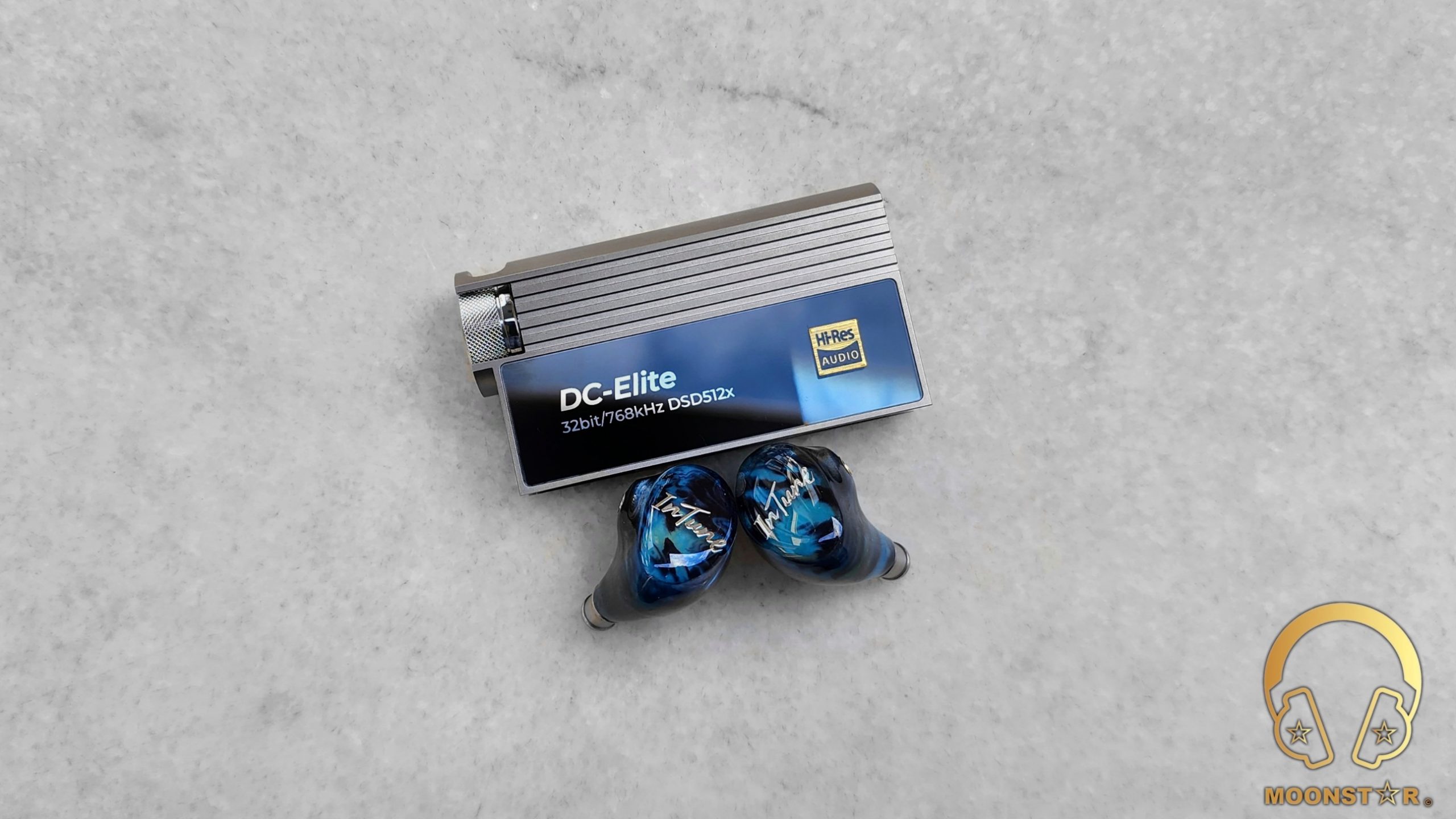
The Sound:
The true essence of the iBasso DC-Elite lies in its sonic signature, and it doesn’t disappoint. The DAC’s ability to unravel intricate layers of sound creates an expansive and highly enjoyable listening experience. The soundstage is broad and well-defined, allowing each instrument and vocal to occupy its own space within the sonic scene. Whether you’re exploring the delicate nuances of classical compositions or surrendering to the pulsating beats of modern genres, the DC-Elite exhibits a versatility with all IEM’s and Headphones I have listen to it.
This review was been written after a burn-in period of about 80 hours. I have paired the DC-Elite with sources like the Samsung Galaxy S22 Ultra and the Asus TUF FX505DU (Laptop PC). My sound impressions below are mainly based on my experiences with the iBasso IT07, Campfire Audio Solaris Stellar Horizon and Westone Audio MACH80 IEM’s and the iBasso SR2 and HiFiMAN Edition XS Headphones.

Bass:
The iBasso DC-Elite delivers an impeccable bass performance. The low frequencies are naturally articulate and dynamic, providing a satisfying thump without compromising on precision. It breathes a nice sense of liveliness into to this area, making each note resonate with a palpable presence when called upon.
Sub-bass rumbles with controlled authority, never bleeding into the midrange that was pretty audible with IEM’s like the iBasso IT07 and Campfire Audio Solaris Stellar Horizon, while listen to track like Lorde’s “Royals” or Daft Punk’s “Doin’ it Right”. Yet, amidst power, there’s a remarkable agility and sense of authority in the midbass area. The decay is clean and controlled, never muddying the sonic landscape. The overall bass performance of the DC-Elite demands your attention, but never overpowers the rest of the sound spectrum.
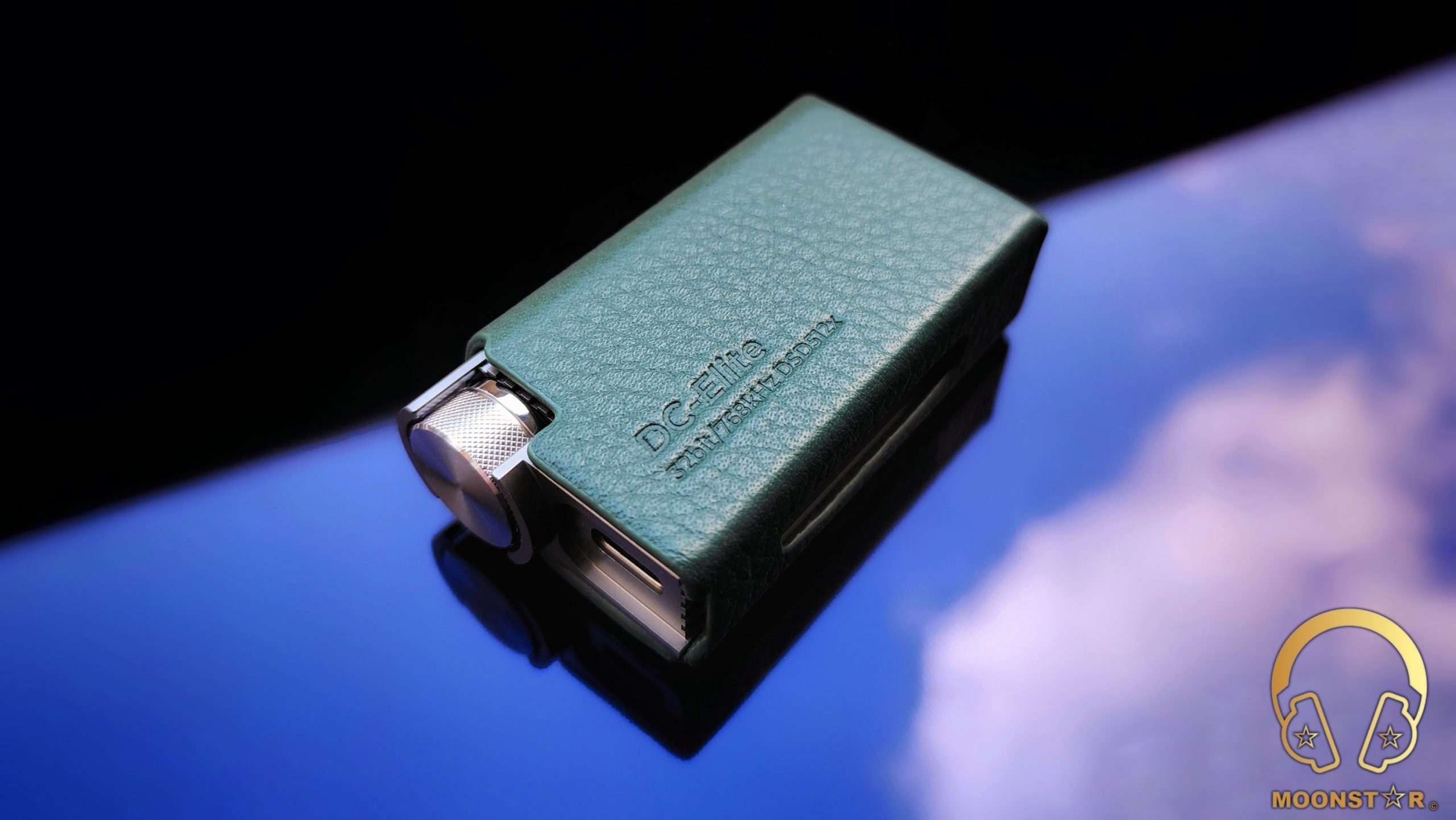
Midrange:
The iBasso DC-Elite’s midrange excels in clarity and detail, showcasing the richness and subtle nuances of vocals. Instruments shine in this range, adding warmth and authenticity to the sound. The lower midrange exhibits a natural character, subtly enriching the audio without overshadowing other frequencies. Male and female voices emerge with clarity and emotion, especially when paired with IEMs like the iBasso IT07 or Meze RAI Penta. Instruments occupy distinct spaces, weaving a cohesive sonic tapestry.
The upper midrange has a natural presence, avoiding undue boosting or recession. Pianos, violins, guitars, and vocals are reproduced with transparency and a pleasing presence. With the right IEM or headphone pairing, vocals like Adele, Diana Krall, or Sertap Erener come alive with intimacy and impact.
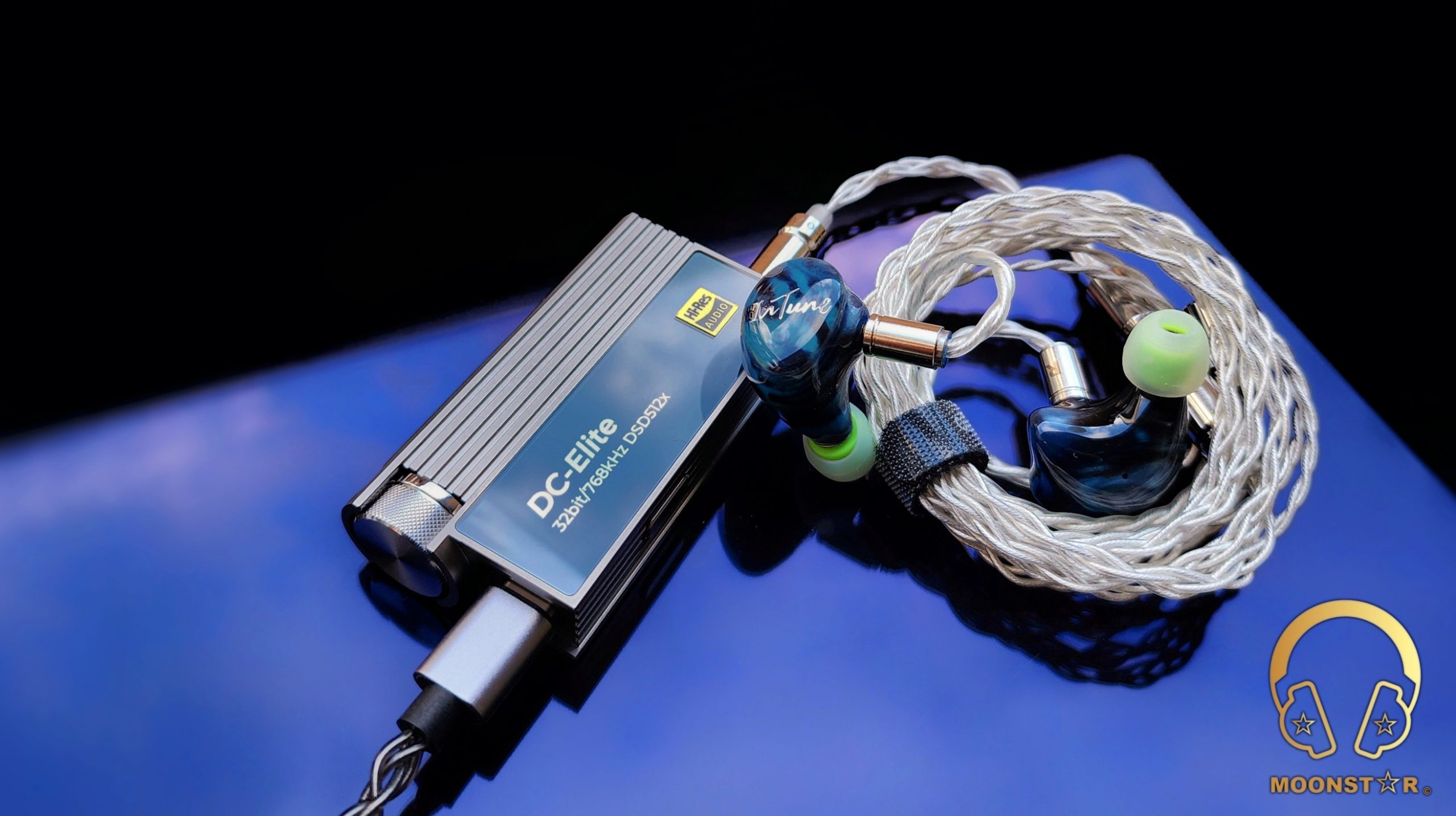
Treble:
In the realm of high frequencies, the iBasso DC-Elite achieves a delicate balance and the treble area is where the DC-Elite truly shines.The treble is crisp, detailed, and extends gracefully, imparting a sense of airiness to the sound without veering into harshness. It preserves the intricate textures of instruments and vocals, ensuring a captivating and fatigue-free listening experience.
It is airy, shows a great sense of brilliance and is extending with a vibrancy that feels expansive and open. Cymbals shimmer with a natural decay, adding sparkle and air to the soundscape. Hi-hats and percussion articulate with precise attack and sustain, adding detail and texture to complex passages such like tracks in Charly Antolini’s Knock Out 2000 Album. Yet, despite this airiness, the treble avoids harshness or sibilance. It remains smooth and controlled that was again pretty audible while listen to IEMs like the Campfire Audio Supermoon and iBasso IT07, as well as headphones like the HiFiMAN Edition XS.
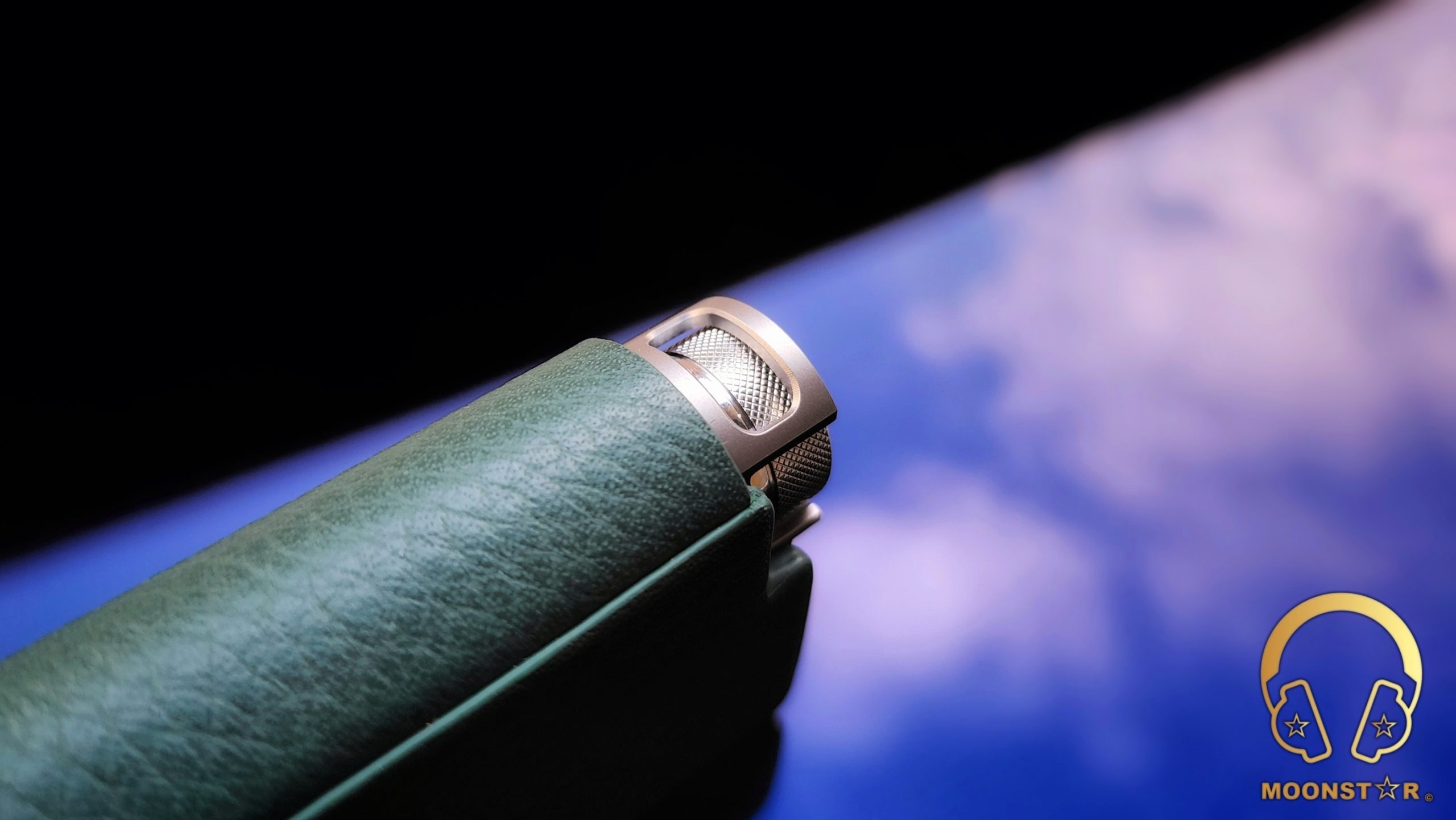
Soundstage & Imaging:
The iBasso DC-Elite conjures a surprisingly spacious soundstage for its diminutive form. Instruments are precisely positioned across a well-defined stereo image, creating a sense of separation and depth. The DC-Elite shows a pretty expansive, holographic stage and surpasses most portable DAC/amps Dongles on the market. This spaciousness enhances the overall listening experience, drawing you deeper into the music and fostering a sense of immersion.
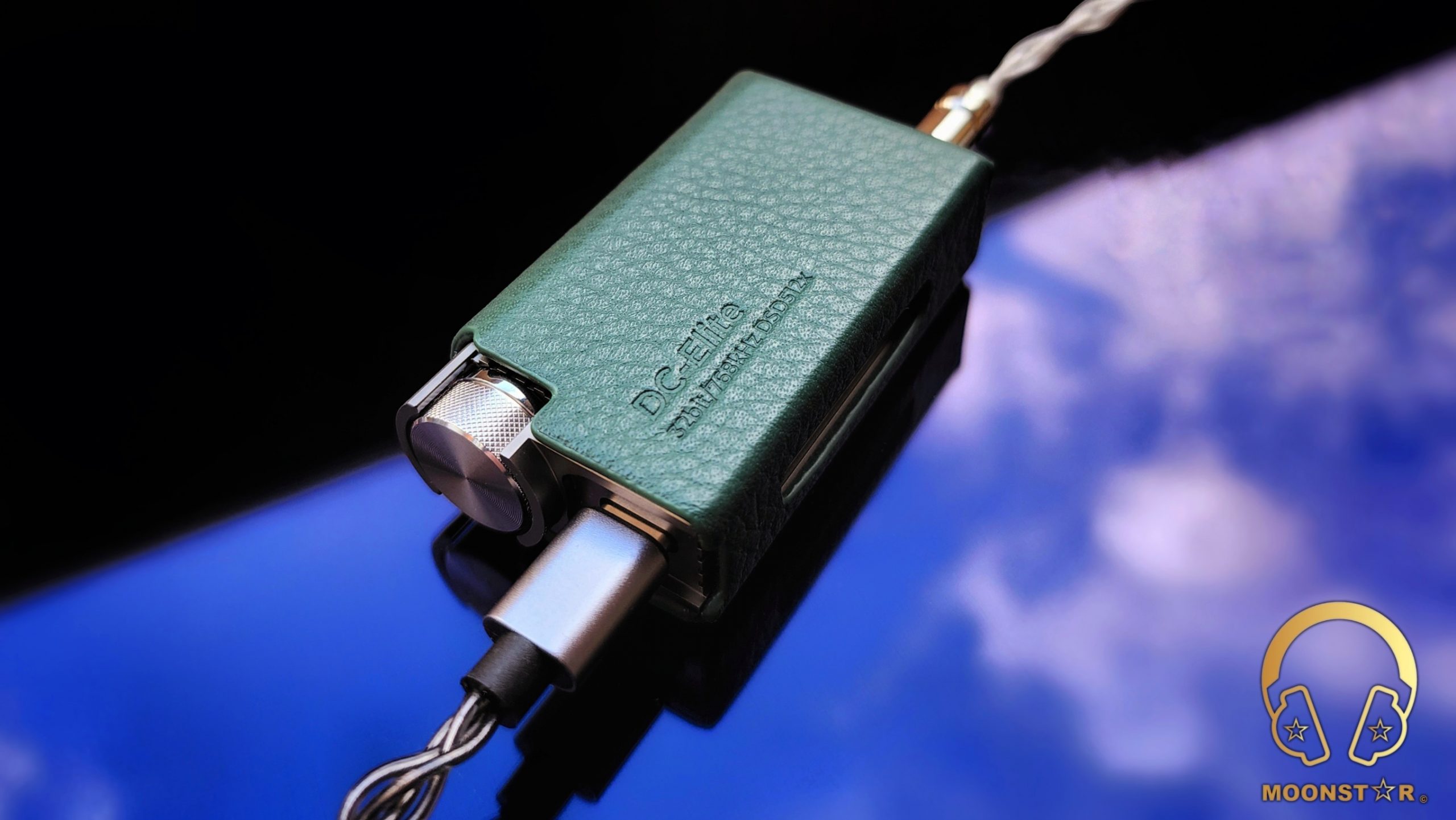
Comparison:
iBasso DC-Elite versus Cayin RU7:
The realm of portable DAC/amps has two new kings vying for the crown: the enigmatic Cayin RU7, draped in the allure of its resistor-based R2R architecture, and the iBasso DC-Elite, wielding a fearsome arsenal of technical prowess. We delved into the heart of their sonic landscapes, dissecting their performances in bass, midrange, treble, and soundstage, to declare a victor in this clash of titans.
The RU7 descends into the low end with a smooth, organic touch. Its bass is present, weighty, and controlled, but lacks the visceral punch and dynamism of the DC-Elite. The iBasso flexes its technical muscle, delivering bass with surgical precision and impressive extension. Sub-bass rumbles with authority, transients slam with impact, and layers unravel with finesse. While the RU7’s bass is undeniably pleasant, the DC-Elite paints a more vivid picture, etching every detail onto the sonic canvas.
The Cayin RU7’s midrange is rich, textured, and brimming with warmth. Vocals unfold with a touch of sweetness, guitars resonate with a woody timbre, and wind instruments sing with a breathy clarity. While the iBasso DC-Elite also boasts a respectable level of warmth and musicality courtesy of its BD34301EKV DAC chip, it prioritizes a different dimension: clarity and resolution. Vocals and instruments emerge with a cleaner, crisper edge, revealing nuances that might lie veiled in the RU7’s warmer embrace. This focus on technical prowess translates to superior separation and layering in the DC-Elite’s midrange, avoiding congestion or distortion even in complex passages. This ultimately grants it the upper hand in terms of detail retrieval and intricate textures, particularly evident when dissecting the fine lines within instruments and vocals.
The RU7’s treble is smooth and forgiving, extending without sibilance or harshness. Cymbals shimmer with a gentle decay, and high-pitched melodies retain their melodic character. The DC-Elite’s treble is airier and more revealing, bringing out the intricate details of cymbal work and showcasing the full spectrum of high-frequency information. This airiness can occasionally border on brightness, but it lends a sense of spaciousness and fidelity that the RU7’s more laid-back treble lacks.
The RU7 throws a wide soundstage, but it tends to lacks the sense of depth and layering that the DC Elite has. The DC-Elite, on the other hand, conjures a more holographic soundscape. Instruments exist within a pretty three-dimensional space, with distinct front-to-back and left-to-right positioning.
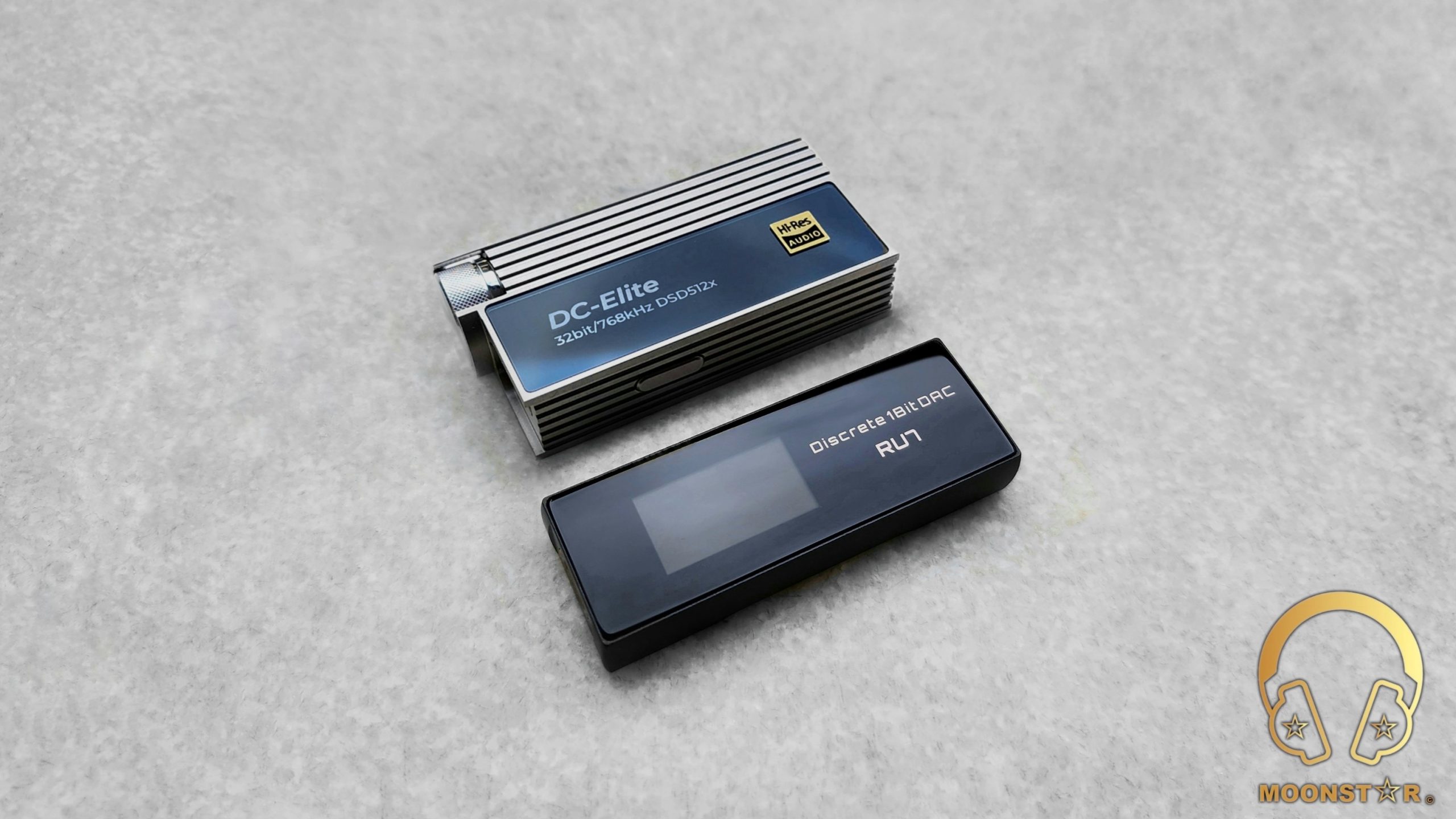
Conclusion:
The iBasso DC-Elite redefines what’s possible from a portable DAC/Amp dongle. Its combination of cutting-edge hardware, meticulous engineering, and refined sonic signature culminates in a listening experience that transcends its compact form factor. From intricate classical pieces to energetic modern tracks, the DC-Elite delivers unparalleled transparency, power, and precision, effortlessly driving a wide range of headphones and IEMs. If you’re seeking the ultimate portable audio upgrade, the DC-Elite should be on your list.

Pros & Cons:
- + Effortless Overall Sonic Performance
- + Ultra Clean Background
- + Stable and Powerful Output
- + Cutting-edge Hardware (ROHM BD34301EKV, 6 dual OPAMPs, 4 section stepped attenuator, etc.)
- + Sleek and durable Titanium alloy Housing
- + Eye-Catching Design
- + Package includes Premium Leather case & Apple Lightning Cable
- – No MQA Support
- – UAC APP is missing some features like OTA FW Update, PEQ Options, etc.
- – TOTL Price for a TOTL DAC/AMP Dongle
Thank you for the Read!

